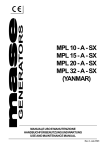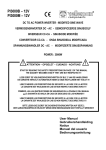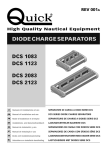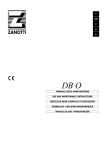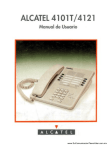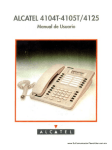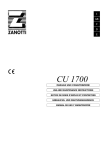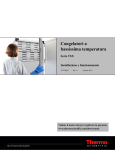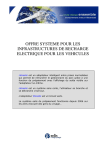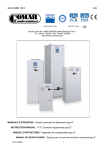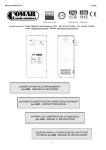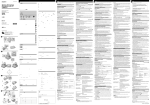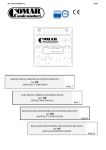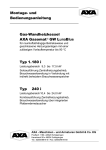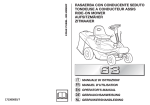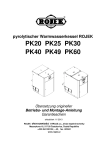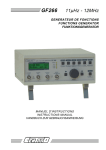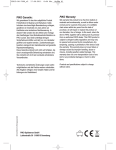Download MPL 10 SX - CX MPL 15 SX - CX MPL 20 SX - CX MPL 40 SX
Transcript
GENERATORS MPL MPL MPL MPL MPL MPL 10 SX - CX 15 SX - CX 20 SX - CX 40 SX - CX 65 SX - CX 80 SX - CX MANUALE USO E MANUTENZIONE USE AND MAINTENANCE MANUAL GEBRAUCHSANWEISUNG UND WARTUNGSVORSCHRIFTEN MANUEL D'INSTRUCTIONS ET D'ENTRETIEN Cod. 41382 Nomefile:mum_mpl.pm5 Data di aggiornamento: 02/06/97 Redatto: C.A. GENERATORS MPL SX - CX 7 1 2 3 4 5 6 1 -2- MPL SX - CX GENERATORS 6 5 1 4 2 3 2 5 4 3 1 2 3 -3- MPL SX - CX GENERATORS 18 16 17 2 1 15 3 4 19 20 21 6 5 7 8 9 10 12 13 11 14 4 -4- MPL SX - CX GENERATORS Schema elettrico MPL 10-15 SX - CX (M) 6 7 9 8 10 11 5 12 4 13 17 3 15 22 14 23 21 16 2 18 19 20 1 Rif. Descrizione Rif. Descrizione 1 2 3 4 5 6 7 8 9 10 11 12 13 14 15 16 17 18 19 20 21 22 23 Presa trifase 3p + n + t 32 A Presa monofase 2 p + t 16 A Morsetto collegamento terra Magnetotermico - differerenziale Commutatore voltometrico Voltmetro Frequenzimetro Contaore Amperometro Alternatore Rotore Diodi di eccitazione -5- Motorino avviamento Chiave accensione Modulo protezioni motore Connettore colleg. quadro avviam. automatico Pulsante arresto emergenza Pressostato olio Sensore sovratemperatura aria Indicatore riserva carburante Elettrovalvola stop Alternatore DC Batteria 12 V MPL SX - CX GENERATORS Schema elettrico MPL 10-15 SX - CX (NSM) 6 7 12 9 8 10 11 24 5 4 13 17 3 22 15 14 23 21 16 2 18 19 20 1 Rif. Descrizione Rif. Descrizione 1 2 3 4 5 6 7 8 9 10 11 12 13 14 15 16 17 18 19 20 21 22 23 24 Presa trifase 3p + n + t 32 A Presa monofase 2 p + t 16 A Morsetto collegamento terra Magnetotermico - differerenziale Commutatore voltometrico Voltmetro Frequenzimetro Contaore Amperometro Alternatore Rotore Diodi di eccitazione -6- Motorino avviamento Chiave accensione Modulo protezioni motore Connettore colleg. quadro avviam. automatico Pulsante arresto emergenza Pressostato olio Sensore sovratemperatura aria Indicatore riserva carburante Elettrovalvola stop Alternatore DC Batteria 12 V Regolatore elettronico di tensione MPL SX - CX GENERATORS Schema elettrico MPL 20 SX - CX (E) 9 7 6 8 10 11 5 12 4 13 17 3 22 15 14 23 16 2 18 19 20 21 1 Rif. Descrizione Rif. Descrizione 1 2 3 4 5 6 7 8 9 10 11 12 13 14 15 16 17 18 19 20 21 22 23 Presa trifase 3p + n + t 32 A Presa monofase 2 p + t 16 A Morsetto collegamento terra Magnetotermico - differerenziale Commutatore voltometrico Voltmetro Frequenzimetro Contaore Amperometro Alternatore Rotore Diodi di eccitazione -7- Motorino avviamento Chiave accensione Modulo protezioni motore Connettore colleg. quadro avviam. automatico Pulsante arresto emergenza Pressostato olio Sensore sovratemperatura aria Indicatore riserva carburante Elettrovalvola stop Alternatore DC Batteria 12 V MPL SX - CX GENERATORS Schema elettrico MPL 20 SX - CX (M) 7 6 9 8 10 11 5 12 13 4 3 6 17 22 15 14 21 16 18 2 19 20 23 1 Rif. Descrizione Rif. Descrizione 1 2 3 4 5 6 7 8 9 10 11 12 13 14 15 16 17 18 19 20 21 22 23 Presa trifase 3p + n + t 32 A Presa monofase 2 p + t 16 A Morsetto collegamento terra Magnetotermico - differerenziale Commutatore voltometrico Voltmetro Frequenzimetro Contaore Amperometro Alternatore Rotore Regolatore elettronico di tensione -8- Motorino avviamento Chiave accensione Modulo protezioni motore Connettore colleg. quadro avviam. automatico Pulsante arresto emergenza Pressostato olio Sensore sovratemperatura aria Indicatore riserva carburante Elettrovalvola stop Alternatore DC Batteria 12 V MPL SX - CX GENERATORS Schema elettrico MPL 40 - 65 SX - CX (VM -M) 9 10 12 11 13 14 8 15 7 16 19 5 6 17 26 18 20 4 3 21 22 23 2 24 1 Rif. Descrizione 1 2 3 4 5 6 7 8 9 10 11 12 13 14 25 15 Regolatore elettronico di tensione Rif. Descrizione Presa trifase 3p + n + t 32 A Presa monofase 2 p + t Magnetotermico unipolare Magnetotermico tripolare Morsettiera collegamento di potenza Morsetto collegamento terra Magnetotermico - differerenziale Commutatore voltometrico Voltmetro Frequenzimetro Contaore Amperometro Alternatore Rotore 16 17 18 19 20 21 22 23 24 25 26 -9- Motorino avviamento Chiave accensione Modulo protezioni motore Pulsante arresto emergenza Elettrovalvola stop Connettore colleg. quadro avviam. automatico Pressostato olio Termostato aria Indicatore riserva carburante Batteria Alternatore DC MPL SX - CX GENERATORS MECC ALTE ECN 31 LC - 10 - I GENERATORS INDICE IL MANCATO RISPETTO DELLE SPECIFICHE CONTENUTE NEL SEGUENTE MANUALE DI INSTALLAZIONE, COMPORTA IL DECADIMENTO DELLA GARANZIA SUL PRODOTTO Figure ..................................................................... 2 Schemi elettrici ..................................................... 5 1 1.1 1.2 1.3 1.4 Informazioni generali ................................... 12 Scopo del manuale .......................................... 12 Documentazione allegata ................................. 13 Identificazione della macchina .......................... 13 Descrizione della macchina ............................. 13 2 Caratteristiche ............................................... 14 2.1 Caratteristiche tecniche ................................... 14 3 Norme di sicurezza ....................................... 15 3.1 Precauzioni ...................................................... 15 3.2 Collegamento del gruppo a terra ....................... 15 4 4.1 4.2 4.3 4.4 Utilizzo del generatore ................................. 15 Controlli preliminari .......................................... 15 Avviamento ....................................................... 15 Arresto ............................................................. 16 Collegamento al quadro automatico ................. 16 5 Protezioni ....................................................... 16 6 6.1 6.2 6.3 6.4 6.5 6.6 6.7 6.8 Manutenzione ................................................ 17 Manutenzione ordinaria del motore ................... 17 Cambio olio motore .......................................... 17 Disareazione impianto ...................................... 17 Sostituzione filtro aria ....................................... 18 Pulizia delle griglie di aspirazione ..................... 18 Periodo di inattività ........................................... 18 Tavola interventi programmati ........................... 18 Tavola guasti .................................................... 18 - 11 - MPL SX - CX I GENERATORS MPL SX - CX 1 INFORMAZIONI GENERALI Consultare attentamente questo manuale prima di procedere a qualsiasi intervento sulla macchina. 1.1 Scopo del manuale Grazie per aver scelto un prodotto MASE. Questo manuale è stato redatto dal Costruttore e costituisce parte integrante del corredo del gruppo elettrogeno. Le informazioni contenute sono dirette agli utilizzatori e alle persone incaricate alla loro manutenzione. Il manuale definisce lo scopo per cui la macchina è stata costruita e contiene tutte le informazioni necessarie per garantirne un uso sicuro e corretto. La costante osservanza delle indicazioni, in esso contenute, garantisce la sicurezza dell’uomo della macchina, l’economia d’esercizio ed una maggiore durata della macchina stessa. Per facilitare la consultazione esso è stato suddiviso in sezioni che ne identificano i concetti principali; per una consultazione rapida degli argomenti consultare l’indice descrittivo. Le parti di testo da non trascurare sono state evidenziate in grassetto e precedute da simboli qui di seguito illustrati e definiti. PERICOLO Indica che è necessario prestare attenzione al fine di non incorrere in serie conseguenze che potrebbero provocare la morte del personale o possibili danni alla salute. ATTENZIONE Situazione che potrebbe verificarsi durante il periodo di vita di un prodotto, sistema o impianto considerato a rischio in materia di danni alle persone, alle proprietà, all’ambiente o di perdite economiche. CAUTELA Indica che è necessario prestare attenzione al fine di non incorrere in serie conseguenze che potrebbero portare al danneggiamento di beni materiali quali le risorse o il prodotto INFORMAZIONI Indicazioni di particolare importanza. I disegni sono forniti a scopo esemplificativo. Anche se la macchina in vostro possesso si differenzia sensibilmente dalle illustrazioni contenute in questo manuale la sicurezza e le informazioni sulla stessa sono garantite. Il costruttore, nel perseguire una politica di costante sviluppo ed aggiornamento del prodotto, può apportare modifiche senza preavviso. - 12 - I GENERATORS 1.2 Documentazione allegata Parte integrante del presente manuale è la seguente documentazione: - Dichiarazione CEE di conformità; - Manuale uso e manutenzione del motore; - Libretto SERVICE; - Certificato di garanzia; - Cartolina di garanzia. 1.3 Identificazione della macchina Vedere FIG.1 1 - Codice macchina 2 - Fattore di potenza 3 - Frequenza dichiarata 4 - Potenza continua 5 - Tensione nominale 6 - Corrente 7- Numero di serie Vedere FIG. 2 1 - Panello strumenti 2 - Portellone di accesso al motore 3 - Bocchettone rifornimento carburante 4 - Griglie aspirazione aria di raffreddamento 5 - Griglia scarico aria di raffreddamento 6 - Tubo scarico fumi di combustione I dati che identificano il nro di codice della macchina, il nro di matricola e l’anno di costruzione devono essere sempre precisati al costruttore per informazioni, richieste di ricambi, ecc. 1.4 Descrizione della macchina FIG. 4 Legenda 1 - Modulo protezioni motore 2 - Voltmetro 3 - Frequenzimetro 4 - Amperometro 5 - Contaore 6 - Commutatore voltometrico 7 - Chiave di accensione 8 - Interruttore magnetotermico differenziale 9 - Interruttore magnetotermico 10 - Presa monofase 32 A 2p + t 11 - Presa trifase 32 A 4 p+ n + t 12 - Pulsante di arresto di emergenza 13 - Morsetto per collegamento a terra 14 - Connettore allacciamento quadro automatico - 13 - MPL SX - CX Il gruppi elettrogeni della serie MPL-SX e CX (10 - 15 - 20 - 40 - 65) sono stati progettati per impiego in campo industriale utilizzando motorizzazioni di alta affidabilità del tipo diesel a 1500 giri, raffreddamento ad aria. Particolare attenzione è stata posta al grado di protezione, da agenti esterni; alla salvaguardia del motore, tutela delle parti elettriche da sovraccarichi o sovratemperature con sistemi automatici in grado di arrestare il gruppo in caso di anomalie di funzionamento. I gruppi della serie MPL - SX e CX risultano essere particolarmente silenziosi grazie ad una cabina insonorizzante, internamente coibentata e ad un sistema avanzato d'insonorizzazione dello scarico dei fumi di combustione. Gli alternatori impiegati sono del tipo sincrono autoeccitato autoregolati, in grado di erogare correnti di spunto estremamente elevate con stabilità di tensione inferiore al 5%. I GENERATORS MPL SX - CX 2. CARATTERISTICHE 2.1 Caratteristiche tecniche MODELLO GENERATORE Tipo Potenza cont. Tensione Frequenza Corrente Cos φ Grado di protezione 10 SX - CX VA V Hz A IP MOTORE Tipo Modello Cilindri n. Alimentazione Potenza KW Cilindrata cm³ Aspirazione Giri / m Capacità serbatoio l. Consumo orario Impianto elettrico Dimen. (LxLxA) Peso VA V Hz A IP MOTORE Tipo Modello Cilindri n. Alimentazione Potenza KW Cilindrata cm³ Aspirazione Giri / m Capacità serbatoio l. Consumo orario Impianto elettrico Dimen. (LxLxA) Peso 15 SX-CX (SAME) 20 SX - CX (VM) sincrono, 3 ~ fasi. 15000 400 50 21,6 0,8 23 sincrono, 3 ~ fasi. 15000 400 50 21,6 0,8 23 sincrono, 3 ~ fasi. 20000 400 50 28,8 0,8 23 VM SUN 2105 2 Diesel 20,6 1992 Atmosferica 1500 72 SAME 1052 LP 2 Diesel 19,9 2078 Atmosferica 1500 72 VM SUN 2105 2 Diesel 20,6 1992 Atmosferica 1500 72 4,5 12 2000x900x1500 800 4,9 12 2000x900x1500 800 5 12 2000x900x1500 800 20 SX-CX (SAME) 40 SX-CX (VM) 65 SX-CX (VM) sincrono, 3 ~ fasi. 19000 400 50 27,5 0,8 23 sincrono, 3 ~ fasi. 40000 400 50 57,8 0,8 23 sincrono, 3 ~ fasi. 50000 400 50 72,2 0,8 23 SAME 1052 LP 2 Diesel 19,9 2078 Atmosferica 1500 72 SAME 10003.A 3 Diesel 31,6 3000 Atmosferica 1500 96 VM SUN 4105T 4 Diesel 56,6 3980 Compressore 1500 96 4,9 12 2000x900x1500 800 6,7 12 2850x900x1755 920 11,6 12 2850x900x1755 1200 sincrono, 3 ~ fasi. 10000 400 50 14,4 0,8 23 LOMBARDINI 9 LD 625/2 2 Diesel 10,9 1248 Atmosferica 1500 72 l/h 3,5 V 12 mm 2000x900x1500 Kg 800 MODELLO GENERATORE Tipo Potenza cont. Tensione Frequenza Corrente Cos φ Grado di protezione 15 SX-CX (VM) l/h V mm Kg - 14 - MPL SX - CX I GENERATORS 3. NORME DI SICUREZZA 3.1 Precauzioni Leggere attentamente i Manuali delle istruzioni per l’uso e la manutenzione prima di procedere alle operazioni di avviamento e impiego. Il Costruttore declina ogni responsabilità per danni a persone o cose, conseguenti l’inosservanza delle norme di sicurezza. Esaminare attentamente le targhe segnaletiche di sicurezza applicate sulla macchina e rispettarne le indicazioni in esse contenute attenzione alla sezione del cavo da utilizzare. Per il collegamento del cavo di terra utilizzare l'apposito morsetto posto sul pannello prese (Fig. 4 Rif. 11). Per il collegamento a terra, seguire le indicazioni della tabella per la scelta della sezione del cavo da utilizzare in funzione della potenza del gruppo. Potenza KVA 10÷20 20÷40 40÷60 Sezione mm² 10 20 30 60÷80 80÷100 40 50 - Non consentire l’uso del gruppo elettrogeno a persone non competenti o senza una adeguata istruzione. - Non consentire a bambini o animali di avvicinarsi al gruppo elettrogeno in funzione. - Non accedere al generatore con mani bagnate essendo il generatore una potenziale fonte di shock elettrici se mal utilizzato. - Eventuali controlli su gruppo elettrogeno vanno eseguiti a motore spento; controlli con il gruppo in funzione vanno effettuati solo da personale specializzato. PERICOLO Prima di eseguire operazioni di controllo o manutenzione sul gruppo elettrogeno collegato al quadro automatico di avviamento è obbligatorio settare la funzione BLOCCO o sconnetterlo staccando il connettore di collegamento - I gas di scarico contengono monossido di carbonio ed altri residui nocivi: non far mai funzionare il gruppo in ambienti non adeguatamente aerati. - Non far funzionare il gruppo in vicinanza di luoghi con pericolo di esplosione o incendio. - Il rifornimento del carburante va eseguito esclusivamente a motore spento. - Il collegamento a terra del gruppo va eseguito utilizzando cavo di rame di sezione adeguata. ATTENZIONE Nell’utilizzo del generatore occorre tener presente che nei luoghi bagnati o molto umidi e nei luoghi conduttori ristretti esiste l’obbligo del rispetto degli articoli 313 e 318 del D.P.R. 27/04/55 NR.547, nonché’ del CAP. 11 SEZ. IV della norma C.E.I. 64-8. 3.2 Collegamento del gruppo a terra Per la sicurezza degli utilizzatori il collegamento a terra del gruppo va sempre eseguito prestando particolare - 15 - 4. UTILIZZO DEL GENERATORE 4.1 Controlli preliminari Al primo avviamento del gruppo, dopo aver eseguito un qualsiasi intervento di manutenzione, è buona norma accertarsi sempre: - che l’olio sia a livello tramite l’astina vedi tabella olii consigliati. - Che tutte le utenze elettriche siano disinserite per non avviare il gruppo sotto carico. - Che le tubazioni del combustibile siano integre e correttamente collegate. - Che non vi siano connessioni elettriche in cattivo stato. 4.2 Avviamento Verificare, prima di procedere all’avviamento del gruppo elettrogeno, che tutte le utenze siano disinserite, evitando in tal modo di mettere sotto sforzo il motore ancora freddo. Procedere all’avviamento ruotando in senso orario la chiave dello START (fig. 4 rif. 7) di uno scatto. Si noterà l’accensione di tutti i LED in funzione di autocontrollo per circa 2 sec, in seguito rimarrà acceso il LED di ricarica batteria (fig. 4 rif. 18) e il LED di bassa pressione olio (fig. 4 rif. 16). Avviare il gruppo ruotando completamente la chiave di accensione in senso orario e rilasciare solo ad avviamento avvenuto badando a non superare, in ogni caso, più di 5 sec. ad ogni tentativo. Tutte le protezioni verranno attivate dopo 15" dall'avviamento del gruppo, ed in caso di anomalie di funzionamento, il gruppo verrà arrestato e segnalata l'anomalia con l'accensione della relativa spia. Prima di alimentare gli utilizzi è bene lasciar funzionare, senza carico applicato, il motore per almeno cinque minuti permettendo ad esso di raggiungere progressivamente la temperatura di lavoro. Tale accorgimento, garantirà una maggiore durata del motore ed eliminerà il rischio di grippaggi. GENERATORS I 4.3 Arresto MPL SX - CX Funzione Manuale (simboleggiata dalla mano) Questa funzione consente di avviare manualmente il gruppo elettrogeno, tramite il pulsante di start posto sul quadro automatico, indipendentemente dalla presenza o meno della tensione di rete. Nel caso in cui sia presente la tensione di rete, anche con gruppo elettrogeno avviato manualmente, gli utilizzi saranno sempre alimentati dalla tensione di rete. Qualora la tensione di rete venisse a mancare, con la funzione Manuale settata e il gruppo elettrogeno avviato, il quadro automatico eseguirà lo scambio della linea alimentando gli utilizzi tramite il gruppo elettrogeno. Il gruppo si arresta ruotando completamente in senso antiorario la chiave di accensione (fig. 4 rif. 7) Prima di arrestare il gruppo, si consiglia di farlo funzionare, per alcuni minuti, senza carichi inseriti permettendo, in tal modo, di ridurre le temperature interne del motore e dell’alternatore. 4.4 Collegamento al quadro automatico I gruppi della serie SX e CX sono predisposti per essere collegati ad un quadro di controllo automatico in grado di avviare automaticamente il gruppo elettrogeno ed eseguire la commutazione di linea al mancare della tensione di rete ed eseguire l'operazione inversa quando la tensione di rete è nuovamente disponibile. Inoltre il quadro automatico provvederà a mantenere carica la batteria di avviamento del gruppo elettrogeno anche quando questo sarà spento. Il collegamento del quadro automatico al gruppo avviene tramite un connettore a 6 poli presente sul cruscotto del gruppo (fig. 4 rif. 14) e una spina per il prelievo della corrente da inserire nella presa posta sul cruscotto del gruppo elettrogeno (fig. 4 rif. 11). Funzione Test Col settaggio di questa funzione, il quadro automatico esegue un ciclo di avviamento in automatico del gruppo elettrogeno, al fine di verificarne la funzionalità. Si consiglia di eseguire questo test almeno una volta alla settimana. Funzione Blocco (simboleggiata dal lucchetto) Il settaggio di questa funzione inibisce l'avviamento del gruppo elettrogeno dal quadro automatico. CAUTELA Settare questa funzione quando si operano interventi di manutenzione o riparazione sul gruppo elettrogeno, per impedirne l'avviamento dello stesso, nel caso dovesse mancare la tensione di rete. ATTENZIONE Col quadro automatico collegato al gruppo elettrogeno la chiave di accensione, posta sul cruscotto, deve restare nella posizione OFF . Sul quadro automatico è presente - un selettore per la selezione della funzione desiderata ( MANUALE, AUTOMATICA, BLOCCO, TEST); - quattro spie ad indicare lo stato dei contattori; - quattro spie di funzionamento e allarme; - due pulsanti per l'avviamento e l'arresto. 5. PROTEZIONI I gruppi sono dotati di una serie di protezioni che li salvaguardano da un utilizzo non corretto e da inconvenienti che ne possono pregiudicare l'integrità. Esse sono: Funzione automatico Se il selettore della funzione è posizionato in AUT, il quadro automatico avvierà il gruppo al mancare della tensione di rete. Se il gruppo non si avvia, il quadro eseguirà ulteriori tentativi di avviamento, fino ad massimo di 4, dopo i quali si accenderà una spia ad indicare il mancato avviamento. - Protezione bassa pressione olio Interviene spegnendo il gruppo quando la pressione nel circuito di lubrificazione è insufficiente; il suo intervento è segnalato dall’accensione del LED (fig. 4 rif. 16) E’ generalmente sufficiente reintegrare la quantità di olio mancante per poter riavviare il gruppo. ATTENZIONE Prima di settare la funzione AUT è indispensabile premere il pulsante STOP posto sul quadro automatico o settare la funzione di Blocco per alcuni istanti. Questa operazione è necessaria perché, dopo 10 secondi che il quadro automatico si trova in funzione MANUALE, senza che sia stato eseguito l'avviamento tramite il pulsante di START, si attivano le protezioni che impediranno l'avviamento del gruppo. - 16 - MPL SX - CX I GENERATORS ATTENZIONE ATTENZIONE La protezione bassa pressione olio non da un’indicazione sul livello dell’olio. Un controllo periodico del livello olio è indispensabile al fine di evitare danni al motore. - Protezione alta temperatura motore Controllare il livello dell’olio tramite l’apposita astina graduata . (fig. 2 rif. 3) Il livello dell’olio deve sempre essere compreso tra le tacche di MAX e MIN incise sull’astina. 6.2 Cambio olio motore Interviene spegnendo il gruppo qualora la temperatura di funzionamento del motore sia troppo elevata. Il suo intervento è segnalato dall’accensione del LED (fig. 4 rif. 19) Il gruppo deve essere riavviato solo dopo aver individuato ed eliminato la causa dell’intervento. - Protezione da cortocircuito e sovraccarico Per una protezione da cortocircuiti e sovraccarichi, i gruppi sono stati dotati di interruttori magnetotermici e interruttori differenziali, i quali intervengono, interrompendo l'erogazione della corrente, qualora si dovesse verificare una condizione di sovraccarico all'alternatore o un cortocircuito. Prima di ripristinare l'erogazione della corrente, riportando la leva del magnetotermico in posizione 'ON' (fig. 4 rif. 8 - 9) è necessario rimuovere la causa che ne ha provocato l'intervento. Sono utilizzati per questo scopo: - Un 'interruttore magnetotermico differenziale generale, che ha il compito d' interrompere l'erogazione della corrente a tutte le prese in caso di cortocircuito, sovraccarico e dispersione di corrente verso terra. (fig. 4 rif. 8) - Interruttori magnetotermici di protezione alle prese di bassa potenza, in grado di interrompere il circuito, qualora venga prelevata una corrente superiore a quella nominale dalla presa stessa. 6. MANUTENZIONE Utilizzare olio AKROS TURBO 15 W 40 I rabbocchi e i caricamenti vanno eseguiti attraverso il foro indicato alla fig. 3 rif. 4. Per informazioni dettagliate al riguardo consultare il manuale uso e manutenzione del motore che accompagna la macchina. Per la sostituire dell’olio motore è necessario prima rimuovere la portina di chiusura inferiore della cassa insonorizzante, togliere il tappo posto sulla coppa olio e lasciarlo defluire dopo aver posto un contenitore di raccolta sotto il telaio. Si consiglia di eseguire lo svuotamento con olio ancora sufficientemente caldo in modo da consentire un agevole deflusso. ATTENZIONE Non disperdere nell'ambiente l'olio esausto in quanto prodotto inquinante. Consegnare l'olio lubrificante esausto presso gli appositi Centri di Raccolta incaricati dello smaltimento. 6.3 Disareazione impianto La presenza di bolle d’aria all’interno dell’impianto di alimentazione è la causa del funzionamento irregolare del motore o l’incapacità di raggiungere il numero di giri nominale. L’aria può penetrare all’interno del circuito di alimentazione attraverso una giunzione non perfettamente a tenuta (tubazione, filtri, serbatoio) o quando il carburante all’interno del serbatoio è al livello minimo. Per eliminare le bolle d’aria all’interno del circuito di alimentazione è necessario, prima di tutto, rimuovere la causa che ne ha permesso l’entrata ed eseguire le seguenti operazioni: CAUTELA Qualsiasi intervento di manutenzione al gruppo elettrogeno va eseguito da personale autorizzato, effettuato a motore spento e dopo averlo lasciato raffreddare a sufficienza. 6.1 Manutenzione ordinaria del motore Gli interventi periodici, da effettuare sul motore, sono riportati sulla tabella: per informazioni più dettagliate consultare il manuale fornito dal costruttore del motore, allegato ad ogni gruppo. - 17 - 1- Allentare le viti di sfiato poste sul filtro carburante e sulla pompa di iniezione (vedere libretto uso e manutenzione del motore). 2- Agire manualmente sulla leva della pompa carburante AC fino a quando dalle viti di sfiato non è fuoriuscita tutta l’aria contenuta all’interno dell’impianto di alimentazione. (fig.3 rif. 5) 4- Riserrare le viti di sfiato ed avviare il motore. 5- Ripetere le operazioni sopra descritte se il funzionamento del motore non risultasse ancora regolare. GENERATORS I MPL SX - CX 6.7 Tavola interventi programmati INFORMAZIONI Fare riferimento al libretto uso e manutenzione del motore per maggiori dettagli sull’impianto di alimentazione. 6.4 Pulizia filtro aria Per un corretto funzionamento, ed una lunga durata del motore, è importante pulire o sostituire periodicamente la cartuccia del filtro aria. Un filtro non efficiente può essere la causa di perdita di potenza del motore e di eccessiva fumosità allo scarico. Per sostituire la cartuccia del filtro aria eseguire le seguenti operazioni: - rimuovere il coperchio in plastica del filtro aria dopo aver svitando completamente le viti di fissaggio. - sostituire la cartuccia del filtro riposizionando correttamente la nuova; - rimontare il coperchio riavvitando correttamente le viti di serraggio. OPERAZIONE ORE Controllo livello olio in coppa Controllo tensione cinghia Pulizia filtro aria Sostutuzione olio carter Verifica livello elettrolito e stato carica batter. Sostituzione filtro combustibile Sostituzione filtro olio Sostituzione cinghia alternatore Registro gioco bilancieri Controllo iniettori Taratura e pulizia iniettori Controllo spazzole alternatore Revisione parziale Revisione generale 10 50 100 150 150 300 300 500 600 600 600 1200 2500 5000 6.8 Tavola guasti Il motorino di avviamento gira ma il motore principale non si avvia. ATTENZIONE Cambiare l'olio e pulire la cartuccia del filtro aria ogni 100 ore di funzionamento. Ridurre gli intervalli se il gruppo elettrogeno lavora in ambienti particolarmente polverosi. - Verificare la presenza di carburante all’interno del serbatoio. (Rifornire) - Verificare se l’elettrovalvola di stop è alimentata. (Consultare Centro Assistenza) - Verificare il funzionamento della pompa carburante . (Consultare Centro Assistenza) 6.5 Pulizia griglie di aspirazione Il pannello di controllo non si attiva ruotando la chiave di accensione Controllare periodicamente la pulizia delle griglie di aspirazione e scarico aria di raffreddamento (fig.2 rif.4-5). e le alette di raffreddamento dei cilindri. Queste devono restare libere da elementi che ostruiscono il regolare flusso dell'aria di raffreddamento (foglie, carta, stracci, ecc.) - Controllare l’integrità dei fusibili di protezione (Sostituire) - Controllare il cavo di collegamento e le connessioni elettriche. (Ricollegare) - Controllare l’integrità della batteria. (Ricaricare o sostituire) 6.6 Periodo di inattività Il gruppo si spegne durante il periodo di lavoro. Se il gruppo deve rimanere inutilizzato per un lungo periodo è necessario eseguire le seguenti operazioni: - sostituire l’olio del carter motore - sostituire il filtro combustibile - Togliere l’iniettore e immettere alcune gocce di olio all’interno della camera di combustione ed eseguire manualmente un paio di rotazioni dell’albero motore; rimontare l’iniettore e chiudere l’aspirazione e lo scarico. - Verificare se è stata attivata una protezione con l’accensione della relativa spia. (Rimuoverne la causa e ritentare l’avviamento) - Controllare la presenza di carburante nel serbatoio. (Ripristinare il livello) Il motore funziona in maniera irregolare. - Controllare i filtri del carburante. (Sostituire) - Controllare il funzionamento della pompa carburante (Sostituire) - Controllare la taratura degli iniettori. (Consultare un Centro Assistenza Autorizzato) - 18 - UK GENERATORS CONTENTS FAILURE TO ADHERE TO THE INSTRUCTIONS AND SPECIFICATIONS CONTAINED IN THIS INSTALLATION MANUAL WILL INVALIDATE THE PRODUCT GUARANTEE. 1. 1.1 1.2 1.3 1.4 GENERALINFORMATION ............................... 20 Scope of the manual .......................................... 20 Attached documentation ................................... 21 Manufacturer-machine identification .............. 21 Machine description ........................................... 21 2. 2.1 SPECIFICATIONS ........................................ 22 Technical specification .................................. 22 3. 3.1 3.2 SAFETY REGULATIONS .................................. 23 Precautions ......................................................... 23 Earthing the generator ....................................... 23 4. 4.1 4.2 4.3 4.4 USING THE GENERATOR ................................ 23 Preliminary checks ............................................ 23 Start-up ................................................................ 23 Stop ...................................................................... 23 Hook up to the automatic control panel ......... 23 5. CUTOUTS .......................................................... 24 6. 6.1 6.2 6.3 6.4 6.5 6.6 6.7 6.8 MAINTENANCE .................................................. 25 Normal maintenance .......................................... 25 Motor oil change ................................................. 25 Deaeration of fuel system .................................. 25 Replacement of air filter ..................................... 25 Topping up the coolant ...................................... 25 Period of inactivity .............................................. 25 Table of scheduled operations .......................... 26 Troubleshooting .................................................. 26 Wiring diagram list ..................................................... 26 - 19 - MPL SX - CX UK GENERATORS MPL SX - CX 1 GENERAL INFORMATION Read this manually carefully before using the machine. 1.1 Scope of the manual Thank you for having chosen a MASE product. This manual was prepared by the Manufacturer and is an integral part of the components supplied with the machine. This information has been prepared for users and the personnel assigned to perform maintenance on such equipment. The manual defines the scope for which the machine was built and contains all the information needed to ensure safe and correct use. Strict compliance with these instructions will guarantee the safety of persons and the machine and will ensure economic operation and extended machine service life. This manual has been divided into sections which identify the main concepts. Consult the table of contents for a quick guide to the various subjects. The most important parts of the text are indicated in bold and are preceded by the symbols illustrated and described below. DANGER This indicates that operators must be very careful to avoid serious consequences which might lead to the death of personnel or create possible health hazards. WARNING A situation that might occur during the useful life of the product, system or plant which is considered at risk in terms of injury to persons or damage to property and the environment or economic losses. CAUTION This indicates that careful attention is needed to avoid serious consequences that might damage material goods such as resources or the product. INFORMATION Particularly important instructions. The drawings are supplied for the sake of examples. Even if your machine differs greatly from the illustrations included in this manual, machine safety and information are still guaranteed. Since the manufacturer is constantly developing and updating the product, changes may be made without prior notice. - 20 - GENERATORS UK 1.2 Attached documentation The generating units in this series MPL-SX and CX (10 15 - 20 - 40 - 65) have been designed for industrial use and are driven by highly reliable, 1500 r.p.m. air-cooled diesel engines. Special attention has been paid to: the degree of protection against foreign bodies; safeguarding the engine; protecting the electrical components from surges or excessively high temperatures. This is achieved through an automatic system able to shut down the unit if any malfunction arises. The MPL - SX and CX units are particularly silent thanks to a fully insulated, soundproofed cabin and to an advanced system for soundproofing the exhaust discharge of combustion fumes Synchronous, self-exciting, self-regulating alternators are employed which can provide extremely high peak currents with a voltage stability of less than 5%. The following documentation is an integral part of this manual: - EEC conformity declaration; - Engine operation and maintenance manual; - Exploded view of spare parts; - SERVICE handbook; - Warranty certificate; - Warranty card. 1.3 Manufacturer-machine identification See FIG. 1 1 - Machine code 2 - Power factor 3 - Rated frequency 4 - Continuous output 5 - Nominal voltage 6 - Power supply 7 - Series number See FIG. 2 1 - Instrument panel 2 - Engine access hatch 3 - Fuel tank opening 4 - Cooling air intake grid 5 - Cooling air discharge grid 6 - Exhaust fume discharge pipe Every request for information, spare parts, etc. must bear the machine identification data, machine number and year of manufacture. 1.4 Description of the machine FIG. 4 Key 12345678910 11 12 13 14 - MPL SX - CX Engine protection module Voltmeter Frequency meter Ammeter Counter Voltmeter transformer Ignition key Magnetothermic differential switch Magnetothermic switch Single-phase outlet 32 A 2p + t Three-phase outlet 32 A 4p + n + t Emergency shut-off switch Terminal for ground connection Connector for hook up to the automatic control panel - 21 - UK GENERATORS MPL SX - CX 2 SPECIFICATIONS 2.1 Technical specifications MODEL GENERATOR Type Power Voltage Frequency Current Power factor Degree of protec. ENGINE Type Model No. of cylinders Fuel Power supply Displacement Intake r.p.m. Tank capacity 10 SX - CX VA V Hz A Cos φ IP KW cm³ l. Hourly consumption l/h Electrical system volt Size (LxWxH) mm Weight Kg MODEL 15 SX-CX (VM) 15 SX-CX (SAME) synchronous - 3 ph. synchronous - 3 ph. synchronous - 3 ph. 10000 15000 15000 400 400 400 50 50 50 14.4 21.6 21.6 0.8 0.8 0.8 23 23 23 KW cm³ l. Hourly consumption l/h Electrical system volt Size (LxWxH) mm Weight Kg synchronous - 3 ph. 20000 400 50 28.8 0.8 23 LOMBARDINI 9 LD 625/2 2 Diesel 10.9 1248 Atmospheric 1500 72 VM SUN 2105 2 Diesel 20.6 1992 Atmospheric 1500 72 SAME 1052 LP 2 Diesel 19.9 2078 Atmospheric 1500 72 WM SUN 2105 2 Diesel 20.6 1992 Atmospheric 1500 72 3.5 12 2000x900x1500 800 4.5 12 2000x900x1500 800 4.9 12 2000x900x1500 800 5.0 12 2000x900x1500 800 20 SX-CX (SAME) 40 SX-CX (VM) 65 SX-CX (VM) GENERATOR Type synchronous - 3 ph. synchronous - 3 ph. synchronous - 3 ph. Power VA 19000 40000 50000 Voltage V 400 400 400 Frequency Hz 50 50 50 Current A 27.45 57.8 72.2 Power factor Cos φ 0.8 0.8 0.8 Degree of protec. IP 23 23 23 ENGINE Tipe Model No. of cylinders Fuel Power supply Displacement Intake r.p.m. Tank capacity 20 SX - CX (VM) SAME 1052 LP 2 Diesel 19.9 2078 Atmospheric 1500 72 SAME 10003.A 3 Diesel 31.6 3000 Atmospheric 1500 96 VM SUN 4105T 4 Diesel 56.6 3980 Compressor 1500 96 4.9 12 2000x900x1500 800 6.7 12 2850x900x1755 920 11.6 12 2850x900x1755 1200 - 22 - MPL SX - CX UK GENERATORS tions to be used; these depend on the power rating of the generator. 3 SAFETY REGULATIONS 3.1 Precautions Power Carefully read the Instruction and Maintenance Manuals before starting up and using the machine. Section mm² 10 The manufacturer declines any responsibility for damages to persons or things stemming from noncompliance with the safety standards. Carefully examine the safety panels applied to the machine and follow their contents to the letter. - Do not allow unqualified or inadequately trained personnel to use the generator. - Keep children or animals away from the generator when it is running. - Do not approach the generator with wet hands as it is a potential source of electrical shock if improperly used. - Do not perform any operations on the generator unless the motor is off; tests which require the motor to be running must only be performed by specialized personnel. DANGER When the generator is connected to an automatic start-up panel, before any tests or maintenance can be performed, it must be locked out - by selecting the BLOCK function - or disconnected - by disengaging the connector. - The exhaust fumes contain carbon monoxide and other harmful substances; never run the unit in an inadequately ventilated area. - Do not run the unit in the vicinity of areas where there is the risk of explosion or fire. - Refuelling must only be performed when the engine is off. - The unit is grounded using an adequate diameter copper cable. KVA 10÷20 20÷40 40÷60 60÷80 80÷100 20 30 40 50 4 USING THE GENERATOR 4.1 Preliminary checks The first time the unit is started up after maintenance, a good rule of thumb is always to make certain that: - the oil is at the required level. This is done using the dip stick: see table for the suggested oils. - the electrical devices are off so that the generator will not start up under a load. - the fuel pipes are in good condition and properly connected. - no electrical connections are in poor condition. 4.2 Start-up Before starting up the generator, make certain that all devices are off so as to prevent forcing the engine when it is cold. Proceed with start-up by rotating the START key (fig. 4 ref. 7) clockwise one click. All the LEDs will light up for approximately 2 seconds as the self-check is performed. The battery recharge LED (fig. 4 ref. 18) and the low oil pressure LED (fig. 4 ref. 16) will then remain on. Start up the unit by turning the ignition key clockwise all the way; only release it when the engine has cut in. However, in no case should the key be held down for more than 5 seconds in an attempt to start up the engine. All protections cut in 15 sec. after the unit is started up and, in case of malfunction, the unit will shut down and a warning light will go on indicating the malfunction. Before turning on any of the devices, leave the engine running without any load for at least five minutes. This will allow it to reach operating temperature gradually thus ensuring maximum engine life and preventing seizing. 4.3 Shut down PRECAUTION When using the generator, bear in mind that in wet or very damp places and in confined, conductive spaces the following regulations must be complied with: Chap. 11, sect. IV of CEI regulation 64-8. 3.2 Grounding the unit For user safety the unit must always be grounded paying particular attention to the section of the cable used. Connect the ground cable with the special terminal located on the outlet panel (Fig. 5 Ref. 13). Make ground connections following the table indicating the cable sec- - 23 - The unit is shut down by turning the ignition key (fig. 4 ref. 7) all the way counter-clockwise. Before shutting down the unit, it is advisable to let it run for a few minutes without any load thus lowering the temperature inside the engine and the alternator. 4.4 Hook up to the automatic control panel The series SX and CX units are prepared for connection to an automatic control panel able to automatically start up the generator, to switch lines when line power cuts out and switch back when the line voltage is returned. GENERATORS UK In addition, the automatic control panel maintains the charge in the generator start-up battery, even when the generator is off. MPL SX - CX Block function (padlock) Selecting this function prevents the generator from being started up by the automatic control panel. DANGER The unit is hooked up to the automatic control panel through the 6-pin connector found on the unit instrument panel (fig. 4 ref. 14) and a power supply plug inserted in the outlet located on the generator instrument panel (fig. 4 ref. 11). Select this function whenever maintenance or repairs are being performed on the unit. This will prevent the generator from being accidentally started up in case the line power cuts out. ATTENTION When the generator is connected to the automatic control panel the ignition key located in the instrument panel must remain in the OFF position. 5 PROTECTIONS The automatic control panel has the following parts: - a function selector (MANUAL, AUTOMATIC, BLOCK, TEST); - four warning lights indicating the status of the contactors; - four operating warning lights and alarms; - two buttons, one for start up and one for shut down. The units are equipped with a series of protections to safeguard them from improper use and from failures which could compromise their function. These protect against: - Low oil pressure Automatic operation If the function selector is in the AUT position, the automatic control panel will start up the unit whenever the line voltage cuts out. If the unit is not on, the panel will make a maximum of 4 attempts to turn it on. If these prove unsuccessful, a warning light will go on indicating that start up has failed. This cuts in, turning off the unit, whenever there is inadequate pressure in the lubrication circuit; when it cuts in a LED (fig. 4 ref. 16) goes on. In this case, adding additional oil is usually enough to start up the unit once more. ATTENTION ATTENTION The low oil pressure protection does not provide any indication as to the oil level. To prevent damaging the engine, it is essential to check the oil level periodically. Before setting the AUT function, it is essential to press the STOP button located on the automatic control panel or set the BLOCK function for a few instants. This operation is required because, after the automatic control panel has been operating in MANUAL for 10 seconds, if the start-up is not performed by pressing the START button, the protections will cut in preventing start up. - High engine temperature This protection cuts in, turning off the unit whenever the engine operating temperature is too high. When activated a LED (fig. 4 ref. 19) goes on. In this case, the unit can only be started up again after the cause has been identified and eliminated. Manual operation (hand) This function makes it possible to start up the generator manually whether there is voltage from the mains or not. This is done using the START button located on the automatic control panel. If the mains are powered, the equipment will, in any case, be powered from the mains even when the generator is on. - Short circuits and overloads To protect against short circuits and overloads, the unit is equipped with magnetothermic and differential breakers which cut off the power supply when the alternator is overloaded or there is a short circuit. Before powering the unit again by flipping the magnetothermic breaker levers (fig. 4 ref. 8-9) back to the ON position, the problem which caused it to trip must be removed. For this purpose the following breakers are used: - the general differential magnetothermic circuit breaker: in the case of short circuit, overload and current leakage to ground, this cuts off the power supply to all outlets (fig. 4 ref. 8). When Manual function has been selected and the generator is on, should the line power cut out, the automatic control panel will switch the power supply line so that the equipment is powered by the generator. Test function Setting the unit to this function, the automatic control panel will perform an automatic start-up cycle in order to check generator function. It is advisable to perform this test at least once a week. - 24 - MPL SX - CX UK GENERATORS - Magnetothermic circuit breakers to the low voltage outlets; these break the circuit whenever the voltage at a given outlet is higher than the nominal voltage for that particular outlet. 6 MAINTENANCE PRECAUTION All maintenance operations on the generator must be performed by authorized personnel. Maintenance must be performed after the engine has been turned off and has cooled down sufficiently. 6.1 Ordinary engine maintenance first place. The following operations must then be performed: 1 - Turn the ignition key clockwise one click so that the shut-off solenoid valve is opened. 2 - Loosen the vent screws located on the fuel filter and on the injection pump (see the engine use and maintenance manual). 3 - Manually manipulate the AC fuel pump lever until the all the air in the system has been eliminated through the vent screws (fig. 3 ref. 5). 4 - Tighten the vent screws once more and start up the engine. 5 - Repeat the above operations if the engine is still not functioning properly. INFORMATIONS The periodic maintenance required for the engine is reported in the table. For more detailed information, see the manual supplied by the engine manufacturer and attached supplied with the generator. ATTENTION Check the oil level using the special, graduated dip stick (fig. 2 ref. 3). The oil level must always be between the MAX and MIN level notches on the stick. 6.2 Changing the engine oil Use AKROS TURBO 15 W 40 oil The oil tank is filled and topped up through the hole indicated in fig. 3 ref. 4. For more detailed information, see the engine use and maintenance manual provided with the machine. To change the engine oil, first remove the lower hatch closing the soundproofing case. Then withdraw the cap located on the oil sump and drain it into a container placed under the body. It is advisable to drain the oil when it is still sufficiently warm as it will flow more easily. ATTENTION Do not disperse spent oil in the environment as it causes pollution. Deliver spent lubricating oil to special Collection Centres which handle disposal. 6.3 Venting the system The presence of air bubbles in the fuel system can cause the engine to run irregularly or prevent it from reaching its nominal r.p.m. Air can penetrate the fuel circuit through imperfectly sealed joints (i.e. piping, filters, tanks) or when the level of fuel in the tank is at a minimum. To eliminate air bubbles from the fuel circuit one must first eliminate the failure which allowed the air to enter in the - 25 - Consult the engine use and maintenance manual for further details on the fuel system. 6.4 Replacing the air filter To ensure proper functioning and long engine life it is important to clean and periodically replace the air filter cartridge. An inefficient filter can cause loss of engine power and can give rise to excessively smoky exhaust. To replace the air filter cartridge operate as follows: - Remove the plastic lid from the air filter after having removed the securing screws; - Remove the filter cartridge and insert a new one positioning it carefully; - Replace the lid and tighten it with the securing screws. ATTENTION Clean the air filter cartridge every 200 hours of operation. Shorten this interval if the generator is operated in a particularly dusty environment. Replace the cartridge when it is excessively fouled or damaged. 6.5 Cleaning the air intake grids Periodically check the cooling air intake and discharge grids (fig. 2 ref. 4-5) and the cylinder cooling fins for fouling. These must be free of any foreign bodies which could obstruct the flow of cooling air (i.e. leaves, paper, rags, etc.). 6.6 Periods of inactivity If the unit will not be used for a long period of time, the following operations must be performed: - replace the engine oil sump; - replace the fuel filter; - remove the injector, insert a few drops of oil inside the combustion chamber and manually rotate the drive shaft a few times; reinstall the injector and close the suction and delivery openings. UK GENERATORS 6.7 Table of scheduled operations OPERATION Check the level of the oil in the sump Check belt tension Clean the air filter Replace the oil sump Check the level of the electrolytes and thebattery charger status Replace the fuel filter Replace the oil filter Replace the alternator belt Regulate the play in the rocker lever Check the injectors Calibrate and clean the injectors Check alternator bushes Partial overhaul General overhaul MPL SX - CX WIRING DIAGRAM LIST MPL 10- 15 SX- CX (M) 1 2 3 4 5 6 7 8 9 10 11 12 13 14 15 16 17 18 19 20 21 22 23 HOURS 10 50 100 150 150 300 300 500 600 600 600 1200 2500 5000 6.8 Troubleshooting The starter motor turns but the main engine does not cut in. - Make certain there is fuel in the tank (refill). - Make certain that the Stop solenoid valve is powered (contact the Service Centre) - Make certain that the fuel pump is functioning (contact the Service Centre) The control panel does not cut in when the ignition key is turned. Socket 3 p + n + e 32A Socket 2 p + e 16 A Output terminal Circuit breaker - earth fault device Commutator Voltmeter Frequency meter Hour counter Ampermeter Stator Rotor Diode bridge Starter Starting key Cutout module Connector Emergency stop button Oil pressure indicator Air thermostat Fuel float Solenoid valve DC alternator Battery WIRING DIAGRAM LIST MPL 10-15 SX- CX (NSM) 1 2 3 4 5 6 7 8 9 10 11 12 13 14 15 16 17 18 19 20 21 22 23 24 - Check the protection fuse (replace) - Check the connection cable and electrical connectors (reconnect) - Make certain that the battery is operative (recharge or replace) The unit cuts out during operation. - Check whether the protection has been activated and the warning light is on (remove the cause and try to start up again) - Make certain there is fuel in the tank (refill) The engine is running irregularly. - Check the fuel filters (replace) - Make certain that the fuel pump is operating properly (replace) - Check calibration of the injectors (contact an Authorized Service Centre) - 26 - Socket 3 p + n + e 32A Socket 2 p + e 16 A Output terminal Circuit breaker - earth fault device Commutator Voltmeter Frequency meter Hour counter Ampermeter Stator Rotor Diode bridge Starter Starting key Cutout module Connector Emergency stop button Oil pressure indicator Air thermostat Fuel float Solenoid valve DC alternator Battery Automatic Voltage Regulator GENERATORS MPL SX - CX UK WIRING DIAGRAM LIST MPL 20 SX- CX (E) WIRING DIAGRAM LIST MPL 40-65 SX- CX (VM-M) 1 2 3 4 5 6 7 8 9 10 11 12 13 14 15 16 17 18 19 20 21 22 23 1 2 3 4 5 6 7 8 9 10 11 12 13 14 15 16 17 18 19 20 21 22 23 24 25 26 Socket 3 p + n + e 32A Socket 2 p + e 16 A Output terminal Circuit breaker - earth fault device Commutator Voltmeter Frequency meter Hour counter Ampermeter Stator Rotor Diode bridge Starter Starting key Cutout module Connector Emergency stop button Oil pressure indicator Air thermostat Fuel float Solenoid valve DC alternator Battery WIRING DIAGRAM LIST MPL 20 SX- CX (M) 1 2 3 4 5 6 7 8 9 10 11 12 13 14 15 16 17 18 19 20 21 22 23 Socket 3 p + n + e 32A Socket 2 p + e 16 A Output terminal Circuit breaker - earth fault device Commutator Voltmeter Frequency meter Hour counter Ampermeter Stator Rotor Diode bridge Starter Starting key Cutout module Connector Emergency stop button Oil pressure indicator Air thermostat Fuel float Solenoid valve DC alternator Battery - 27 - Socket 3 p + n + e 32A Socket 2 p + e 16 A Circuit breaker 1p Circuit breaker 3 p Output terminal Earth terminal Circuit breaker - earth fault device Commutator Voltmeter Frequency meter Hour counter Ampermeter Stator Rotor Automatic Voltage Regulator Starter Starting key Cutout module Emergency stop button Solenoid valve Connector Oil pressure indicator Air thermostat Fuel float Battery D.C. alternator D GENERATORS - INHALT - DIE NICHTBEACHTUNG DER IN DIESEM HANDBUCH AUFGEFÜHRTEN HINWEISE HAT DEN VERFALL DER GARANTIE ZUR FOLGE 1. 1.1 1.2 1.3 1.4 ALLGEMEINE HINWEISE ................................ 29 Zweckdeshandbuchs ..................................... 29 Beigefügtedokumentation .................................. 30 Hersteller - kenndaten des Gerätes .............. 30 Beschreibung des Gerätes ........................... 30 2. 2.1 CHARAKTERISTIKEN .................................. 31 Technische Daten ......................................... 31 3. 3.1 3.2 SICHERHEITSVORSCHRIFTEN ................... 32 Vorsichtsmaßnahmen ................................... 32 Erdung des Aggregates ................................. 32 4. 4.1 4.2 4.3 4.4 BETRIEB DES STROMAGGREGATES ......... Kontrollen vor Inbetriebnahme ....................... Start .............................................................. Stopp ............................................................ Anschluß an Automatiktafel .......................... 5. SCHUTZEINRICHTUNGEN ........................... 33 6. 6.1 6.2 6.3 6.4 6.5 6.6 6.7 6.8 WARTUNG ................................................... Ordentliche Wartung des Motor ..................... Motorölwechsel ............................................. Entlüftung der Anlage .................................... Wechsel des Luftfilters .................................. Reiningung des Ansauggrills ......................... Stillstandszeiten ........................................... Wartungstabelle ............................................ Fhlersuche .................................................... 32 32 32 33 33 34 34 34 34 34 35 35 35 35 - 28 - MPL SX - CX GENERATORS D MPL SX - CX 1. ALLGEMEINE HINWEISE Bevor Sie jegliche Art von Eingriff auf die Maschine vornehmen, lesen Sie aufmerksam dieses Handbuch. 1.1 ZWECK DES HANDBUCHS Danke, daß Sie sich für ein MASE Produkt entschieden haben. Dieses Handbuch wurde vom Hersteller verfaßt und ist ein Bestandteil der Maschinenausstattung. Die Hinweise richten sich an Benutzer und Personen, die mit der Wartung der Maschine beauftragt sind. Das Handbuch beschreibt den Zweck, zu dem diese Maschine gebaut wurde und enthält alle notwendigen Hinweise, um einen sicheren und korrekten Gebrauch zu garantieren. Die Beachtung aller in diesem Handbuch enthaltenen Hinweise garantiert die Sicherheit des Menschen und der Maschine, die Betriebseinsparung und eine längere Lebensdauer der Maschine. Um Ihnen das Nachschlagen zu erleichtern, ist das Handbuch in Kapitel unterteilt, die mit den Grundbegriffen betitelt sind; für ein schnelleres Finden der Argumente, ziehen Sie die Inhaltsangabe heran. Besonders wichtige Textpassagen sind fettgedruckt und mit hier im folgenden aufgelisteten Zeichen versehen. GEFAHR Weist darauf hin, daß besondere Aufmerksamkeit erforderlich ist, um Vorfälle zu vermeiden, die den Tod oder eventuelle Gesundheitsschäden des Personals hervorrufen könnten. ACHTUNG Diese Situation könnte während der Lebensdauer eines Produktes, eines Systems oder einer Anlage eintreten, die als gefährlich angesehen werden und Schäden an Personen, Eigenschaften und der Umwelt hervorrufen oder finanziellen Verlust zur Folge haben könnten. VORSICHT Weist darauf hin, daß besondere Aufmerksamkeit erforderlich ist, um Vorfälle zu vermeiden, die Schäden an Material und Maschine hervorrufen könnten. HINWEISE Hinweise von besonderer Wichtigkeit. Die Zeichnungen dienen nur als Beispiele. Auch wenn Ihre Maschine wesentlich von den in diesem Handbuch abgebildeten abweicht, wird für die Sicherheit und die Richtigkeit der Hinweise garantiert. In dem Bemühen um eine Produktionspolitik mit konstanter Fortentwicklung behält sich der Hersteller das Recht vor, ohne Vorankündigung Produktänderungen vorzunehmen. - 29 - GENERATORS D 1.2 BEILIEGENDE DOKUMENTATION Die stromerzeugenden Aggregate der Serie MPL-SX und CX (10 - 15 - 20 - 65) sind für den industriellen Einsatz mit Antrieb durch ausgesprochen zuverlässige luftgekühlte Dieselmotoren mit 1.500 Umdrehungen konzipiert worden. Besondere Aufmerksamkeit wurde auf den Schutzgrad gegen äußere Einwirkungen und auf den Schutz des Motors verwendet; alle elektrischen Bauteile werden mit automatischen Systemen gegen Überlast und zu hohe Temperaturen geschützt, die in der Lage sind, das Aggregat bei Funktionsstörungen anzuhalten. Die Aggregate der Serie MPL - SX und CX sind aufgrund einer innen gedämmten Schalldämpfungskabine und der Verwendung eines fortschrittlichen Systems des Dämpfung der Geräusche der Verbrennungsabgase besonders leise. Die verwendeten Alternatoren sind synchrone, selbsterregende und selbstregelnde Alternatoren, die in der Lage sind, sehr hohe Spitzenstromstärken mit einer Spannungsstabilität von unter 5% abzugeben. Die folgende Dokumentation stellt einen integralen Bestandteil des vorliegenden Handbuches dar: - Erklärung zur CE-Konformität; Bedienungs- und Wartungsanleitung des Motors; SERVICE-Handbuch; Garantie-Zertifikat; Garantiekarte. 1.3 HERSTELLER - IDENTIFIZIERUNG DER MASCHINE Siehe Abbildung 1 1234567- Maschinenkennummer Leistungsfaktor angegebene Frequenz Dauerleistung Nominalspannung Stromstärke Seriennummer Siehe Abbildung 2 123456- MPL SX - CX Instrumententafel Inspektionsklappe Motor Einfüllstutzen Kraftstoff Ansauggrill Kühlluft Auslaßgrill Kühlluft Auslaßleitung Verbrennungsgase Die Daten zur Identifizierung der Kennummer der Maschine, der Seriennummer und des Baujahres müssen bei Anfragen an den Hersteller, bei der Bestellung von Ersatzteilen usw. immer angegeben werden. 1.4 BESCHREIBUNG DER MASCHINE Abbildung 5 1 - Modul Motorschutz 2 - Voltmeter 3 - Frequenzmeter 4 - Amperemeter 5 - Stundenzähler 6 - Voltmetrischer Umschalter 7 - Zündschlüssel 8 - Magnetothermischer Differentialschalter 9 - Magnetothermischer Schalter 10 -Einphasensteckdose 32 A 2p + t 11 -Dreiphasensteckdose 32 A 4p + n + t 12 -Notaustaste 13 -Erdungsklemmleiste 14 -Steckverbindung Anschluß Automatiktafel - 30 - MPL SX - CX D GENERATORS 2. EIGENSCHAFTEN 2.1 TECHNISCHE EIGENSCHAFTEN MODELL GENERATOR Typ Leistung Spannung Frequenz Stromstärke Cos φ Schutzgrad MOTOR Typ Modell Zylinder Speisung Leistung Hubraum Ansaugung U/min Tankvolumen Verbrauch/St. Elektrik Abmessungen Gewicht 10 SX - CX MOTOR Typ Modell Zylinder Speisung Leistung Hubraum Ansaugung U./min Tankvolumen Verbrauch/St. Elektrik Abmessungen Gewicht 15 SX-CX (SAME) 20 SX - CX (VM) synchron, Dreiphasen synchron, Dreiphasen synchron, Dreiphasen synchron, Dreiphasen 10000 15000 15000 20000 400 400 400 400 50 50 50 50 14,4 21,6 21,6 28,8 0,8 0,8 0,8 0,8 IP 23 23 23 23 VA V Hz A St. KW cm³ l. l/h V mm Kg MODELL GENERATOR Typ Leistung Spannung Frequenz Stromstärke Cos φ Schutzgrad 15 SX-CX (VM) VA V Hz A IP LOMBARDINI 9 LD 625/2 2 Diesel 10,9 1248 Atmosphärische 1500 72 VM SUN 2105 2 Diesel 20,6 1992 Atmosphärische 1500 72 SAME 1052 LP 2 Diesel 19,9 2078 Atmosphärische 1500 72 VM SUN 2105 2 Diesel 20,6 1992 Atmosphärische 1500 72 3,5 12 2000x900x1500 800 4,5 12 2000x900x1500 800 4,9 12 2000x900x1500 800 5 12 2000x900x1500 800 20 SX-CX (SAME) 40 SX-CX (VM) 65 SX-CX (VM) synchron, Dreiphasen synchron, Dreiphasen synchron, Dreiphasen 19000 40000 50000 400 400 400 50 50 50 27,5 57,8 72,2 0,8 0,8 0,8 23 23 23 l. SAME 1052 LP 2 Diesel 19,9 2078 Atmosphärische 1500 72 SAME 10003.A 3 Diesel 31,6 3000 Atmosphärische 1500 96 VM SUN 4105T 4 Diesel 56,6 3980 Kompressor 1500 96 l/h V mm Kg 4,9 12 2000x900x1500 800 6,7 12 2850x900x1755 920 11,6 12 2850x900x1755 1200 St. KW cm³ - 31 - GENERATORS D 3.2 ERDUNG 3. SICHERHEITSBESTIMMUNGEN Zur Sicherheit der Benutzer muß bei der Ausführung der Erdung auf den Querschnitt des verwendeten Kabels geachtet werden. Benutzen Sie für den Anschluß des Erdungskabels die entsprechende Klemme auf dem Anschlußpaneel (Abbildung 5 - 13). Folgen Sie bei der Erdung den Angaben der folgenden Tabelle für den Querschnitt des zu verwendenden Kabels in Abhängigkeit von der Leistung des Aggregats. 3.1 VORSICHTSMAßNAHMEN Lesen Sie die Bedienungs- und Wartungshandbücher vor der Inbetriebnahme und der Benutzung aufmerksam durch. Der Hersteller lehnt jegliche Haftung für Schäden an Personen oder Sachen ab, die auf der Nichtbeachtung der Sicherheitsbestimmungen beruhen. Leistung kVA 10÷20 20÷40 40÷60 60÷80 80÷100 Schauen Sie sich die auf der Maschine angebrachten Sicherheitsschilder genau an und beachten Sie die in ihnen enthaltenen Angaben. - Verhindern Sie, daß Kinder oder Tiere sich an den laufenden Generator annähern. - Fassen Sie den Generator nie mit nassen Händen an, da bei falscher Benutzung des Generators die Gefahr eines elektrischen Schlags besteht. - Querschnitt mm2 Gestatten Sie die Benutzung der Maschine keinen unbefugten oder unzureichend ausgebildeten Personen. - MPL SX - CX Betreiben Sie den Generator nicht in der Nähe von explosions- oder brandgefährdeten Orten. - Das Nachfüllen von Kraftstoff darf ausschließlich bei stehendem Motor erfolgen. - Die Erdung des Generators wird unter Verwendung eines Kupferkabels von geeigneter Stärke ausgeführt. 40 50 Vor dem ersten Anlassen des Aggregats und nach der Ausführung von Wartungsarbeiten sollte stets überprüft werden: Vor der Ausführung von Kontroll- oder Wartungsarbeiten an dem an eine automatische Starttafel angeschlossenen Generator muß die SPERR-Funktion eingestellt werden oder die Steckverbindung muß gezogen werden. - 30 4.1 KONTROLLEN VOR ARBEITSBEGINN - der richtige Ölstand: Meßstab. Siehe Tabelle der empfohlenen Öle; - daß alle elektrischen Verbraucher ausgeschaltet sind, damit das Aggregat nicht unter Last eingeschaltet wird; - daß die Kraftstoffleitungen unversehrt und richtig angeschlossen sind; - daß keine beschädigten elektrischen Leiter vorhanden sind. GEFAHR Die Abgase enthalten Kohlenmonoxid und andere gesundheitsschädliche Substanzen; nehmen Sie den Generator nicht in Betrieb, wenn eine ausreichende Lüftung nicht gewährleistet ist. 20 4. BENUTZUNG DES GENERATORS Eventuelle Kontrollarbeiten an dem Generator werden immer mit stehendem Motor ausgeführt; Kontrollarbeiten mit laufendem Motor dürfen ausschließlich von Fachpersonal ausgeführt werden. - 10 4.2 ANLASSEN Überprüfen Sie vor dem Anlassen des Generators, daß alle Verbraucher abgeschaltet sind, um eine Belastung des noch kalten Motors zu vermeiden. Das Aggregat wird gestartet, indem der Zündschlüssel (Abbildung 4 - 7) um eine Position nach rechts gedreht wird. Beim Anlassen leuchten alle LEDs zur Selbstkontrolle für ca. 2 Sekunden auf, danach bleiben die LED ‘Batterie nachladen’ (Abbildung 4 - 18) und die LED ‘Öldruck niedrig’ (Abbildung 4 16) an. Das Aggregat anlassen, indem der Zündschlüssel ganz nach rechts gedreht wird; erst loslassen, nachdem das Anlassen erfolgt ist, der Startversuch darf aber in keinem Fall mehr als fünf Sekunden dauern. Alle Schutzvorrichtungen werden 15 Sekunden nach dem Anlassen aktiviert und bei Funktionsstörungen wird das Aggregat angehalten und die entsprechende Kontrolleuchte leuchtet auf. ACHTUNG Bei der Verwendung des Generators muß stets berücksichtigt werden, daß bei nassen oder sehr feuchten Orten und bei engen Leiterzonen die Beachtung der 313 und 318 des Erlasses des Regierungspräsidenten vom 27. 04. 55 Nr. 547 sowie des Abschnitts 11, Teil IV der CEI-Norm 64-8 vorgeschrieben ist. - 32 - MPL SX - CX D GENERATORS Vor dem Speisen der Verbraucher sollte der Motor fünf Minuten ohne Last laufen, damit er nach und nach die Betriebstemperatur erreicht. Dies garantiert eine längere Lebensdauer des Motors und verringert die Gefahr des Festfressens. 4.3 ANHALTEN Das Aggregat wird angehalten, indem der Zündschlüssel (Abbildung 4 - 7) ganz nach links gedreht wird. Es wird empfohlen, das Aggregat vor dem Abschalten einige Minuten ohne eingeschaltete Last zu betreiben, um die Temperatur im Motor und im Alternator zu senken. 4.4 ANSCHLUß AN AUTOMATIKTAFEL Die Aggregate der Serie SX und CX sind für den Anschluß an Automatiktafeln vorbereitet, die den Generator automatisch einschalten und die Leitung umschalten, wenn die Netzspannung unterbrochen wird sowie die umgekehrte Operation ausführen, sobald die Netzspannung wieder zur Verfügung steht. Außerdem hält die Automatiktafel die Anlasserbatterie des Generators auch dann geladen, wenn dieser ausgeschaltet ist. Der Anschluß der Automatiktafel an das Aggregat erfolgt mit einer 6-poligen Steckverbindung auf dem Armaturenbrett des Aggregats (Abbildung 4 - 14) und einem Stecker zur Abnahme der Spannung, der in die Steckdose auf dem Armaturenbrett des Aggregats eingesteckt wird (Abbildung 4 - 11). ACHTUNG Schutzvorrichtungen des Aggregats eingreifen, wenn das Anlassen mit der Taste START nicht innerhalb von 10 Sekunden erfolgt, wenn die Automatiktafel sich in der Funktion MANUELL befindet. Manuelle Funktion (angezeigt durch das Symbol ‘Hand’) Diese Funktion gestattet das manuelle Anlassen des Generators mit der Starttaste auf der Automatiktafel, unabhängig davon, ob die Netzspannung vorhanden ist oder nicht. Wenn die Netzspannung vorhanden ist, so werden die Verbraucher auch bei eingeschaltetem Generator immer von der Netzspannung gespeist. Falls die Netzspannung ausfällt, wechselt die Automatiktafel bei eingeschalteter manueller Funktion und laufendem Aggregat die Leitung und speist die Verbraucher mit dem Aggregat. Testfunktion Wenn diese Funktion eingestellt wird, führt die Automatiktafel beim Einschalten einen automatischen Test des Aggregats durch, um dessen Funktionsbereitschaft zu überprüfen. Es wird empfohlen, diesen Test zumindest einmal pro Woche auszuführen. Sperrfunktion (angezeigt durch das Symbol ‘Schloß’) Die Einstellung dieser Funktion sperrt das Anlassen des Aggregats durch die Automatiktafel. VORSICHT Stellen Sie diese Funktion bei Wartungs- oder Reparaturarbeiten an dem Generator ein, um ein Anlaufen desselben bei Stromausfällen zu verhindern. Wenn die Automatiktafel an den Generator angeschlossen ist, muß der Zündschlüssel auf dem Armaturenbrett in der Position OFF bleiben. Auf der Automatiktafel ist vorhanden: - ein Wahlschalter zur Wahl der gewünschten Funktion (MANUELL, AUTOMATIK, SPERRE, TEST); - vier Kontrolleuchten für den Status der Kontaktgeber; - vier Kontrolleuchten für Funktionsweise und Alarme; - zwei Tasten zum Anlassen und Anhalten. Automatikfunktion Falls der Wahlschalter auf AUT gestellt ist, läßt die Automatiktafel den Generator an, sobald die Netzspannung ausfällt. Falls das Aggregat nicht anläuft, werden maximal vier weitere Startversuche ausgeführt und danach leuchtet eine Kontrolleuchte auf, die anzeigt, daß das Aggregat nicht gestartet worden ist. ACHTUNG Vor dem Einstellen der Automatikfunktion muß unbedingt die Stopptaste auf der Automatiktafel gedrückt oder die Sperrfunktion für einige Sekunden eingestellt werden. Dies ist erforderlich, weil die - 33 - 5. SCHUTZVORRICHTUNG Die Aggregate sind mit einer Reihe von Schutzvorrichtungen ausgestattet, die sie gegen eine unrichtige Benutzung und gegen Funktionsstörungen schützen, die sie beschädigen könnten. Dazu zählen: - Schutz gegen niedrigen Öldruck Greift ein, indem das Aggregat abgeschaltet wird, wenn der Druck in der Schmierungsanlage ungenügend ist; der Eingriff wird immer durch das Aufleuchten der LED (Abbildung 4 - 16) angezeigt. Es ist im allgemeinen ausreichend, Öl nachzufüllen, um das Aggregat wieder anlassen zu können. ACHTUNG Der Schutz gegen zu niedrigen Öldruck ist keine Anzeige des Ölstands. Zur Vermeidung von Schäden am Motor ist eine regelmäßige Überprüfung des Ölstands unverzichtbar. D GENERATORS - Schutz gegen hohe Temperatur des Motors Konsultieren Sie für detaillierte Angaben das mit der Maschine gelieferte Bedienungs- und Wartungshandbuch des Motors. Beim Ölwechsel muß zuerst die untere Verschlußklappe des Schalldämpfunsgehäuses abgenommen werden; dann den Stopfen der Ölwanne abnehmen und das Öl in einen unter dem Rahmen aufgestellten Behälter laufen lassen. Es wird empfohlen, das Öl abzulassen, wenn der Motor noch warm ist, damit es besser fließt. Greift ein, indem das Aggregat abgeschaltet wird, wenn die Betriebstemperatur des Motors zu hoch ist. Der Eingriff wird durch das Aufleuchten der LED (Abbild 4 - 19) angezeigt. Das Aggregat darf erst wieder angelassen werden, nachdem die Ursache des Eingreifens gefunden und behoben worden ist. - MPL SX - CX ACHTUNG Schutz gegen Kurzschluß und Überlast Das Altöl muß gemäß der geltenden Umweltschutzbestimmungen entsorgt werden. Geben Sie Altöl bei den autorisierten Annahmestellen ab. Zum Schutz gegen Kurzschluß und Überlast wurden magnetothermische Schalter und Differentialschalter verwendet, die eingreifen und die Stromabgabe unterbrechen, wenn eine Überlastung des Alternators oder ein Kurzschluß auftritt. Vor dem Wiedereinschalten des Stroms durch Stellen des Hebels des magnetothermischen Schalters (Abbildung 4 - 8-9) in die Position ‘ON’ muß die Ursache gefunden werden, die den Eingriff ausgelöst hat. Diese Schalter haben die folgenden Aufgaben: - ein allgemeiner magnetothermischer Differentialschalter hat die Aufgabe, bei einem Kurzschluß, bei Überlastung oder bei Dispersion gegen Erde die Stromabgabe an allen Steckdosen zu unterbrechen (Abbildung 4 - 8). - Magnetothermische Schutzschalter an den Steckdosen mit niedriger Leistung unterbrechen die Schaltung, wenn eine Stromstärke abgenommen wird, die über der Nominalleistung der Steckdose liegt. 6.3 ENTLÜFTUNG DER ANLAGE Luftblasen im Innern der Speisungsanlage führen zu einer unregelmäßigen Funktion des Motors oder dazu, daß die Nominaldrehzahl nicht erreicht wird. Die Luft kann durch einen nicht perfekt schließenden Anschluß (Leitungen, Filter, Tank) in das System gelangen, oder wenn der Kraftstoff im Tank den Minimalpegel erreicht. Zur Entlüftung des Systems muß zuerst die Ursache des Eindringens der Luft behoben werden; folgen Sie dann den folgenden Angaben: 1 - Drehen sie den Zündschlüssel um eine Position nach rechts, bis das Magnetventil zum Anhalten geöffnet wird. 2 - Lockern Sie die Ausblasschrauben am Kraftstoffilter und an der Einspritzpumpe (siehe Bedienungs- und Wartungsanleitung des Motors). 3 - Bedienen Sie den Hebel der Kraftstoffpumpe AC von Hand, bis die gesamte im Innern des Systems enthaltene Luft aus den Ausblasschrauben herausgekommen ist (Abbildung 3 - 5). 4 - Ziehen Sie die Schrauben wieder an und lassen Sie den Motor an. 5 - Wiederholen Sie den oben beschriebenen Arbeitsschritt, bis der Motor ordnungsgemäß funktioniert. 6. WARTUNG Sämtliche Wartungseingriffe am Generator müssen mit stehendem Motor und nach einer ausreichenden Abkühlzeit von Fachpersonal ausgeführt werden. 6.1 ORDENTLICHE WARTUNG DES MOTORS Die am Motor vorzunehmenden periodischen Eingriffe werden in der Tabelle wiedergegeben: Konsultieren Sie für detaillierte Angaben das mit jedem Aggregat gelieferte Handbuch vom Hersteller des Motors. HINWEISE Nehmen Sie für weitere Details auf das Bedienungsund Wartungshandbuch der Speisungsanlage Bezug. ACHTUNG Kontrollieren Sie den Ölstand mit dem entsprechenden Meßstab (Abbildung 2 - 3). Der Ölstand muß immer zwischen den beiden Markierungen (MIN. und MAX.) des Meßstabs liegen. 6.4 AUSTAUSCH DES LUFTFILTERS Für eine korrekte Funktion und eine lange Lebensdauer des Motors ist es wichtig, die Patrone des Luftfilters in regelmäßigen Abständen zu reinigen und zu ersetzen. Ein nicht wirkungsvoller Filter kann zu einem Leistungsabfall des Motors und zu einer übermäßigen Rauchentwicklung am Auslaß führen. Gehen Sie beim Austauschen der Patronen des Luftfilters wie folgt vor: 6.2 ÖLWECHSEL MOTOR Verwenden Sie Öl vom Typ AKROS TURBO 15 W 40 Das Ein- und Nachfüllen erfolgt durch die auf Abbildung 3 - 4 gezeigte Öffnung. - 34 - - MPL SX - CX D GENERATORS Entfernen Sie den Plastikdeckel des Filters nach dem Herausdrehen der Befestigungsschrauben. Ersetzen Sie die Filterpatronen und setzen Sie eine neue Patrone auf korrekte Weise ein. Bringen Sie den Deckel wieder an und ziehen Sie die Befestigungsschrauben wieder an. ACHTUNG Reinigen sie die Filterpatronen ca. alle 200 Betriebsstunden. Verkürzen Sie diese Wartungsintervalle, falls der Generator in einer besonders staubigen Umgebung betrieben wird. Ersetzen Sie die Patrone immer, wenn sie stark verschmutzt oder beschädigt ist. 6.8 FUNKTIONSSTÖRUNGEN Der Anlassermotor läuft, aber der Hauptmotor springt nicht an. - Überprüfen, ob Kraftstoff im Tank vorhanden ist. (Nachfüllen.) - Überprüfen, ob das Magnetventil zum Anhalten gespeist wird. (Kundendienst benachrichtigen.) - Überprüfen, ob die Kraftstoffpumpe funktioniert. (Kundendienst benachrichtigen.) 6.5 Reinigung des Ansauggrills Das Kontrollpaneel wird beim Drehen des Zündschlüssels nicht aktiviert. - Sicherungen kontrollieren. (Ersetzen.) - Verbindungskabel und elektrische Steckverbindungen kontrollieren. (Verbinden.) - Batterie kontrollieren. (Nachladen oder ersetzen.) Kontrollieren Sie die Ansauggrills und die Auslaßgrills der Kühlluft (Abbildung 2 - 4-5) und die Kühlrippen der Zylinder in regelmäßigen Abständen; sie müssen stets sauber sein. Es dürfen keinerlei Fremdkörper vorhanden sein, die den Luftstrom der Kühlluft behindern (Blätter, Papier, Lappen usw.). Das Aggregat geht während der Arbeit aus. - Überprüfen, ob eine Schutzvorrichtung aktiviert worden ist - Aufleuchten der entsprechenden Kontrolleuchte (Ursache beheben und Startversuch durchführen.) - Kontrollieren, ob Kraftstoff im Tank vorhanden ist. (Nachfüllen.) 6.6 STILLSTANDSZEITEN Das Motor läuft unregelmäßig. - Kontrollieren Sie den Kraftstoffilter. (Ersetzen.) - Kontrollieren Sie die Funktion der Kraftstoffpumpe. (Ersetzen.) - Die Tarierung der Einspritzung kontrollieren (Wenden Sie sich an eine autorisierte Kundendienststelle.) Falls das Aggregat für einen längeren Zeitraum nicht benutzt wird, so sind die folgenden Arbeitsschritte auszuführen: - Das Motoröl austauschen. - Den Kraftstoffilter auswechseln. - Die Einspritzung abnehmen, einige Tropfen Öl in die Brennkammer geben und die Motorwelle ein paar Mal von Hand drehen; die Einspritzung wieder montieren und Ansaugung und Auslaß schließen. 6.7 WARTUNGSTABELLE Arbeitsschritt Stunden Kontrolle Ölstand in Wanne 10 Kontrolle Riemenspannung 50 Reinigung Luftfilter 100 Ölwechsel 150 Überprüfung Elektrolyt und Status Batterie 150 Ersetzung Kraftstoffilter 300 Ersetzung Ölfilter 300 Ersetzung Riemen Alternator 500 Einstellung Spiel Kipphebel 600 Kontrolle Einspritzung 600 Tarierung und Reinigung Einspritzung 600 Kontrolle Bürsten Alternator 1200 Teilüberholung 2500 Generalüberholung 5000 - 35 - Siehe Abbildung 5 (MPL 10-15 SX-CX M) 1 2 3 4 5 6 7 8 9 10 11 12 13 14 15 16 17 18 19 20 21 22 23 Dreiphasensteckdose 32A 4p + n + t Einphasensteckdose 16A 2p + t Erdungsklemmleiste Magnetothermischer Differentialschalter Voltmetrischer Umschalter Voltmeter Frequenzmeter Stundenzähler Amperemeter Stator Rotor Erregungdiode Anlaßmotor Zündschlüssel Modul Motorschutz Steckverbindung Anschluß Automatiktafel Notaustaste Ölpressostat Luftthermostat Kraftstoffschwimmer Magnetventil DC Alternator Batterie GENERATORS D MPL SX - CX Siehe Abbildung 6 (MPL 10-15 SX-CX NSM) Siehe Abbildung 8 (MPL 20 SX-CX M) 1 2 3 4 5 6 7 8 9 10 11 12 13 14 15 16 17 18 19 20 21 22 23 24 1 2 3 4 5 6 7 8 9 10 11 12 13 14 15 16 17 18 19 20 21 22 23 Dreiphasensteckdose 32A 4p + n + t Einphasensteckdose 16A 2p + t Erdungsklemmleiste Magnetothermischer Differentialschalter Voltmetrischer Umschalter Voltmeter Frequenzmeter Stundenzähler Amperemeter Stator Rotor Erregungdiode Anlaßmotor Zündschlüssel Modul Motorschutz Steckverbindung Anschluß Automatiktafel Notaustaste Ölpressostat Luftthermostat Kraftstoffschwimmer Magnetventil DC Alternator Batterie Elektronischerspannungsregler Dreiphasensteckdose 32A 4p + n + t Einphasensteckdose 16A 2p + t Erdungsklemmleiste Magnetothermischer Differentialschalter Voltmetrischer Umschalter Voltmeter Frequenzmeter Stundenzähler Amperemeter Stator Rotor Elektronischerspannungsregler Anlaßmotor Zündschlüssel Modul Motorschutz Steckverbindung Anschluß Automatiktafel Notaustaste Ölpressostat Luftthermostat Kraftstoffschwimmer Magnetventil DC Alternator Batterie Siehe Abbildung 8 (MPL 40-65 SX-CX VM-M) Siehe Abbildung 7 (MPL 20 SX-CX E) 1 2 3 4 5 6 7 8 9 10 11 12 13 14 15 16 17 18 19 20 21 22 23 1 2 3 4 5 6 7 8 9 10 11 12 13 14 15 16 17 18 19 20 21 22 23 24 25 26 Dreiphasensteckdose 32A 4p + n + t Einphasensteckdose 16A 2p + t Erdungsklemmleiste Magnetothermischer Differentialschalter Voltmetrischer Umschalter Voltmeter Frequenzmeter Stundenzähler Amperemeter Stator Rotor Erregungdiode Anlaßmotor Zündschlüssel Modul Motorschutz Steckverbindung Anschluß Automatiktafel Notaustaste Ölpressostat Luftthermostat Kraftstoffschwimmer Magnetventil DC Alternator Batterie - 36 - Dreiphasensteckdose 32A 4p + n + t Einphasensteckdose 16A 2p + t Leitungsschutzschalter 1p Leitungsschutzschalter 3p Klemmkasten Erdungsklemmleiste Magnetothermischer Differentialschalter Voltmetrischer Umschalter Voltmeter Frequenzmeter Stundenzähler Amperemeter Stator Rotor Elektronischerspannungsregler Anlaßmotor Zündschlüssel Modul Motorschutz Notaustaste Magnetventil Steckverbindung Anschluß Automatiktafel Ölpressostat Luftthermostat Kraftstoffschwimmer Batterie DC Alternator F GENERATORS INDEX LE NON RESPECT DES SPÉCIFICATIONS CONTENUES DANS CE MANUEL D'INSTRUCTIONS ET D'ENTRETIEN ENTRAÎNE L'ANNULLATION DE LA GARANTIE Figures .................................................................... 2 Schémas électriques ............................................. 5 1 1.1 1.2 1.3 1.4 Informations générales ............................. Objet du manuel ........................................... Documentation annexe ................................ Identification du générateur .......................... Description du générateur ............................ 38 38 39 39 39 2 Caractéristiques techniques ..................... 40 3 3.1 3.2 Normes de sécurité ................................... 41 Précautions .................................................. 41 Branchement du groupe à la terre ................ 41 4 4.1 4.2 4.3 4.4 Utilisation du générateur .......................... Contrôles préliminaires ................................. Mise en fonction ........................................... Arrêt ............................................................. Branchement au tableau automatique .......... 5 Protections ................................................. 42 6 6.1 6.2 6.3 6.4 6.5 6.6 6.7 6.8 Maintenance .............................................. Maintenance ordinaire du moteur ................. Vidange huile du moteur ............................... Désaération du circuit .................................. Remplacement du filtre de l’air ..................... Nettoyage des grilles d'aspiration ................. Période d’inactivité ....................................... Tableau interventions programmées ............. Tableau des pannes ..................................... 41 41 41 41 42 42 42 42 42 43 43 43 43 43 Légendes des schémas électriques ................... 44 - 37 - MPL SX - CX F GENERATORS 1 MPL SX - CX INFORMATIONS GENERALES Consulter attentivement ce manuel avant de procéder à une quelconque intervention sur la machine. 1.1 OBJECTIF DU MANUEL Nous vous remercions d’avoir choisi un produit MASE. Ce manuel a été rédigé par le constructeur et fait partie intégrante de la dotation de la machine (1). Les informations contenues dans ce manuel s’adressent aux utilisateurs ainsi qu’aux personnes chargées de l’entretien. L’observation constante des indications figurant dans ce manuel garantit la sécurité du personnel et de la machine, l’économie de fonctionnement ainsi qu’une durée de vie plus longue de la machine. Afin de faciliter la consultation, ce manuel est divisé en chapitres dans lesquels sont expliqués les concepts principaux : pour une consultation rapide des sujets traités, consulter l’index descriptif. Les parties les plus importantes sont rédigées en gras et sont précédées de symboles illustrés et définis ci-après. DANGER Ce symbole indique qu’une attention particulière est nécessaire afin d’éviter des conséquences graves susceptibles de provoquer la mort du personnel ou des dommages possibles pour la santé. ATTENTION Ce symbole indique une situation susceptible d’avoir lieu durant la vie d’un produit, d’un système ou d’une installation et jugée comme une situation à risque en matière de dommages aux personnes, aux propriétés, à l’environnement ou de pertes économiques. PRECAUTION Ce symbole indique qu’une attention particulière est nécessaire afin d’éviter des conséquences graves susceptibles de provoquer des dommages des biens matériels tels que les ressources ou le produit. INFORMATIONS Indications particulièrement importantes. Les dessins sont fournis à titre d’exemple. Même si la machine en votre possession est sensiblement différente des illustrations contenues dans ce manuel, la sécurité ainsi que les informations la concernant sont garanties. Dans le but de poursuivre une politique de développement constant et de mise à jour du produit, le constructeur se réserve le droit d’apporter des modifications sans préavis. - 38 - F GENERATORS 1.2 Documentation annexe La documentation suivante fait partie intégrante de ce manuel. - Déclaration CEE de conformité ; - Manuel d’utilisation et de maintenance du moteur ; - Livret de SERVICE ; - Certificat de garantie ; - Carte de garantie ; 1.3 Constructeur - identification du générateur Voir FIG. 1: 1 - Code générateur 2 - Facteur de puissance 3 - Fréquence déclarée 4 - Puissance continue 5 - Tension nominale 6 - Courant nominale 7 - Numéro de série Les données qui identifient le numéro de code du générateur, le numéro de matricule et l’année de construction doivent toujours être précisées au constructeur pour recevoir renseignements, demandes de pièces de rechange, etc. Voir FIG. 2 1 - Tableau des contrôles 2 - Coffre inspection moteur 3 - Goulotte remplissage gasoil 4 - Grille aspiration air de refroidissement 5 - Grille sortie air de refroidissement 6 - Tuyau de décharge gaz de combustion 1.4 Description du générateur Voir FIG. 4 1Module protections moteur 2Voltmètre 3Fréquencemètre 4Ampèremètre 5Compte-heures 6Commutateur voltmètrique 7Clef pour l’allumage 8Disjoncteur magnétothermique différentiel 9Disjoncteur magnétothermique 10 - Prise monophasée 32A 2p ± t 11 - Prise triphasée 32A 4p ± n + t 12 - Poussoir d’arrêt d’urgence 13 - Borne de branchement à la terre 14 - Borne de connection armoire automatique Les groupes électrogènes de la série MPL-SX et CX (10- - 39 - MPL SX - CX 15-20-40-65) ont été projetés pour une utilisations dans le secteur industriel en utilisant des motorisations de grande fiabilité du type diesel à 1500 tours avec refroidissement à air. Une particulière attention a été donnée au degré de protection contre les agents externes et pour la sauvegarde du moteur et des parties électriques contre les surcharges ou les surtempératures grâce à des systèmes automatiques en mesure d’arrêter le groupe en cas d’anomalies dans le fonctionnement. Les groupes de la série MPL-SX et CX résultent être particulièrement silencieux grâce à une cabine insonore, calorifugée à l’intérieur et grâce à un système avancé d’insonorisation de l’évacuation des fumées de combustion. Les alternateurs utilisés sont du type synchrone autoexcité, ils sont auto-réglés et en mesure de distribuer des courants de démarrage très élevés avec une stabilité de tension inférieure à 5% . F GENERATORS MPL SX - CX 2 CARACTERISTIQUES TECHNIQUES MODELE 15 SX-CX (VM) 15 SX-CX (SAME) 20 SX - CX (VM) synchrone, 3 ~ ph. 15000 400 50 21,6 0,8 23 synchrone, 3 ~ ph. 15000 400 50 21,6 0,8 23 synchrone, 3 ~ ph. 20000 400 50 28,8 0,8 23 LOMBARDINI 9 LD 625/2 2 Diesel 10,9 1248 Atmospherique 1500 72 VM SUN 2105 2 Diesel 20,6 1992 Atmospherique 1500 72 SAME 1052 LP 2 Diesel 19,9 2078 Atmospherique 1500 72 VM SUN 2105 2 Diesel 20,6 1992 Atmospherique 1500 72 Consumation l/h 3,5 Equipment électrique V 12 Dimension (LxLxH) mm 2000x900x1500 Poids Kg 800 4,5 12 2000x900x1500 800 4,9 12 2000x900x1500 800 5 12 2000x900x1500 800 MODELE 20 SX-CX (SAME) 40 SX-CX (VM) 65 SX-CX (VM) synchrone, 3 ~ ph. 19000 400 50 27,5 0,8 23 synchrone, 3 ~ ph. 40000 400 50 57,8 0,8 23 synchrone, 3 ~ ph. 50000 400 50 72,2 0,8 23 SAME 1052 LP 2 Diesel 19,9 2078 Atmospherique 1500 72 SAME 10003.A 3 Diesel 31,6 3000 Atmospherique 1500 96 VM SUN 4105T 4 Diesel 56,6 3980 Compresseur 1500 96 4,9 12 2000x900x1500 800 6,7 12 2850x900x1755 920 11,6 12 2850x900x1755 1200 GENERATEUR Type Puissance cont. Tension Fréquence Courant Cos φ Degré de protection 10 SX - CX VA V Hz A IP MOTEUR Type Modèle Cylindre n. Alimentation Puissance KW Cylindrée cm³ Aspiration Tours / min Capacité réservoir l. GENERATEUR Type Puissance cont. Tension Frequence Courant Cos φ Degré de protection MOTEUR Type Modèle Cylindre Alimentation Puissance Cylindrée Aspiration Tours / min Capacité réservoir VA V Hz A IP n. KW cm³ l. Consumation l/h Equipement électrique V Dimension (LxLxH) mm Poids Kg synchrone, 3 ~ ph. 10000 400 50 14,4 0,8 23 - 40 - MPL SX - CX F GENERATORS 3 NORMES DE SECURITE 4 UTILISATION DU GENERATEUR 3.1 Précautions 4.1 Contrôles préliminaires Lire attentivement les manuels des instructions pour l’utilisation et la maintenance avant de procéder aux opérations de mise en fonction et d’utilisation. A la première mise en fonction du groupe, après avoir exécuté une intervention quelconque de maintenance, il faut toujours s’assurer : - que l’huile est au niveau juste et cela grâce à la tige, voir tableaux des huiles conseillées. - que tous les usagers électriques sont débranchés pour ne pas mettre en fonction le groupe sous charge. - que les tuyaux du combustibles sont intègres et correctement raccordés. - qu’il n’y a pas de branchements électriques en mauvaises conditions. Le constructeur décline toute responsabilité pour les dommages aux personnes ou aux choses dus à l’inobservance des normes de sécurité. Examiner attentivement les plaques de sécurité appliquées sur le générateur et respecter les indications qui y sont contenues. - Ne pas permettre l’utilisation du groupe électrogène à des personnes non compétentes ou sans une préparation adéquate. - Ne pas permettre aux enfants ou aux animaux de s’approcher du groupe électrogène en fonction. - Ne pas accéder au générateur avec des mains mouillées car le générateur est une source potentielle de chocs électriques s’il est mal utilisé. - Les éventuels contrôles sur un groupe électrogène doivent être effectués quand le moteur est éteint : les contrôles avec le groupe en fonction ne doivent être faits que par un personnel spécialisé. - Les gaz d’évacuation contiennent du monoxyde de carbone et d’autres résidus nocifs ; ne jamais faire fonctionner le groupe dans des locaux aérés de façon inadéquate. - Ne pas faire fonctionner le groupe près des lieux présentant des dangers d’explosion ou d’incendie. - Le ravitaillement en carburant ne doit être fait que quand le moteur est éteint. ATTENTION En utilisant le générateur, il faut tenir compte du fait que dans les lieux mouillés ou très humides et dans les endroits conducteurs restreints il existe l’obligation de respecter du CHAP. 11 SECTION IV de la norme C.E.I. 64-8. 3.2 Branchement du groupe à la terre Pour des raisons de sécurité pour les usagers, le branchement à la terre du groupe doit toujours être exécuté en faisant très attention à la section du câble utilisé (voir table suivante). Pour le branchement du fil de terre, utiliser la borne spéciale placée sur le tableau des prises. Puissance kVA 10÷20 20÷40 40÷60 60÷80 80÷100 Section mm² 10 20 30 40 50 - 41 - 4.2 Mise en fonction Vérifier avant de procéder à la mise en fonction du groupe électrogène que tous les usagers sont débranchés en évitant, de cette façon, de mettre sous effort le moteur encore froid. Procéder à la mise en fonction en tournant dans le sens des aiguilles d’une montre la clef du START (fig. 5 réf. 7) d’un déclic. On verra toutes les LED s’allumer en fonction d’autocontrôle pendant environ 2 sec., puis resteront allumées seule la LED de préchauffage des bougies (fig.5 réf.1), la LED de recharge de la batterie et la LED de basse pression de l’huile. La carte électronique de contrôle du groupe pourvoira à alimenter les bougies de préchauffage pendant 20" après quoi on peut mettre en fonction le groupe en tournant complètement la clef d’allumage dans le sens des aiguilles d’une montre et en ne la relâchant que lorsque la mise en fonction a eu lieu en faisant attention à ne pas dépasser, dans tous les cas, plus de 5 sec. pour chaque tentative. Toutes les protections seront activées 30" après la mise en fonction du groupe et en cas d’anomalies dans le fonctionnement, le groupe sera arrêté et l’anomalie sera signalée grâce à l’allumage du relatif voyant. Avant d’alimenter les usagers, il faut laisser fonctionner à vide le moteur pendant cinq minutes au moins en lui permettant d’atteindre progressivement la température de travail. Cette précaution garantira une plus longue vie au moteur et éliminera les risques de grippages. 4.3 Arrêt Le groupe s’arrête en tournant complètement, dans le sens contraire à celui des aiguilles d’une montre, la clef d’allumage (fig.5 réf.7). Avant d’arrêter le groupe, on conseille de le faire fonctionner pendant quelques minutes sans charges introduites en permettant, ainsi, de réduire les températures internes du moteur et de l’alternateur. F GENERATORS 4.4 Branchement au tableau automatique MPL SX - CX Avant de rétablir la distribution du courant, en reportant le disjoncteur magnétothermique en position «ON» (fig. 5 réf 8-9) il faut éliminer la cause qui en a provoqué l’intervention. Dans ce but, on a utilisé : - un disjoncteur magnétothermique différentiel général qui a la tâche d’interrompre la distribution du courant à toutes les prises en cas de court-circuit, surcharge et dispersion de courant vers la terre. - deux disjoncteurs magnétothermiques de protection aux prises de basse puissance en mesure d’interrompre si un courant supérieur au nominal était prélevé de la prise même. Les groupes de la série MPL sont prédisposés pour être branchés à un tableau de contrôle automatique en mesure de faire démarrer automatiquement le groupe électrogène et d’exécuter la commutation de ligne quand la tension du réseau est coupée et d’exécuter l’opération inverse quand la tension du réseau est de nouveau disponible. De plus, le tableau automatique pourvoira à garder la batterie de démarrage du groupe électrogène sous charge même quand il est éteint. Le branchement du tableau automatique au groupe a lieu à travers un connecteur à 6 pôles présent sur le tableau de bord du groupe (fig. 7 réf. 13) et une fiche pour prélever le courant à introduire dans la prise placée sur le tableau de bord du groupe électrogène (fig. 7 réf. 11). 6. MAINTENANCE PRECAUTION 5 PROTECTIONS Toute intervention de maintenance au groupe électrogène doit être exécutée par un personnel autorisé et doit être faite quand le moteur est éteint et qu’il est suffisamment refroidi. Les groupes sont munis d’une série de protections qui les protègent contre une utilisation non correcte et contre les inconvénients qui peuvent en compromettre l’intégrité. Les protections sont : 6.1 Maintenance ordinaire du moteur Les interventions périodiques à faire sur le moteur sont reportées dans le tableau : pour des renseignements plus détaillés, consulter le manuel fourni par le constructeur du moteur et annexé à chaque groupe. - Protection basse pression de l’huile Elle intervient en éteignant le groupe quand la pression dans le circuit de lubrification est insuffisante : son intervention est signalée par l’allumage de la LED (fig. 5 réf. 1). En général, il suffit de réintégrer la quantité d’huile manquante pour pouvoir remettre en fonction le groupe. ATTENTION Contrôler le niveau de l’huile grâce à la tige spéciale graduée. Le niveau de l’huile doit toujours être compris entre les encoches de MAX et de MIN gravées sur la tige. ATTENTION 6.2 Vidange huile moteur La protection de basse pression de l’huile ne donne pas d’indications sur le niveau de l’huile. Un contrôle périodique du niveau de l’huile est indispensable pour éviter des dommages au moteur. Utiliser de l’huile AKROS TURBO 15W 40 Les remplissages et les chargements doivent être faits à travers l’orifice indiqué à la fig.2 réf.1. Pour avoir des renseignements plus détaillés à ce sujet, consulter le manuel d’utilisation et de maintenance du moteur annexé à la machine. Pour vidanger l’huile du moteur, il faut enlever le portillon de fermeture inférieure de la caisse insonore ainsi que le bouchon placé sur le carter à huile et laisser couler l’huile après avoir placé un conteneur de récolte sous le châssis. On conseille d’exécuter la vidange quand l’huile est encore suffisamment chaude pour permettre un écoulement facile. - Protection température élevée de l’eau Elle intervient en éteignant le groupe si la température de fonctionnement du moteur est trop élevée. Son intervention est signalée par l’allumage de la LED (fig. 5 réf. 1). Le groupe ne peut être remis en fonction qu’après avoir repéré et éliminé la cause de l’intervention. - Protection contre court-circuit et surcharge Pour le protéger contre les courts-circuits et les surcharges, le groupe a été muni de disjoncteurs magnétothermiques et de disjoncteurs différentiels qui interviennent en interrompant la distribution du courant s’il devait y avoir une condition de surcharge à l’alternateur ou un court-circuit. 6.3 Désaération du circuit La présence de bulles d’air à l’intérieur du circuit d’alimentation est la cause du fonctionnement irrégulier du moteur - 42 - MPL SX - CX F GENERATORS ou de l’incapacité à atteindre le nombre de tours nominaux. L’air peut pénétrer à l’intérieur du circuit d’alimentation à travers une jonction non parfaitement étanche (tuyau, filtres, réservoir) ou quand le carburant à l’intérieur du réservoir est au niveau minimum. Pour éliminer les bulles d’air à l’intérieur du circuit d’alimentation, il faut d’abord éliminer la cause qui en a permis l’entrée et ensuite exécuter les opérations suivantes : 1 - Dévisser les vis de l’évent placées sur le filtre du carburant et sur la pompe d’injection (voir manuel d’utilisation et de maintenance du moteur). 2 - Agir à la main sur le levier de la pompe du carburant AC jusqu’à ce qu’à travers les vis d’évent ne soit pas sorti tout l’air contenu dans le circuit d’alimentation. 3 - Resserrer les vis d’évent et faire démarrer le moteur. 4 - Répéter les opérations susdécrites si le fonctionnement du moteur n’était pas encore régulier. INFORMATIONS Se référer au manuel d’utilisation et de maintenance du moteur pour avoir plus de détails sur le circuit d’alimentation. 6.4 Remplacement du filtre air Pour garantir un fonctionnement correct et une longue vie au moteur, il est important de remplacer périodiquement la cartouche du filtre à air. Un filtre non efficace peut être la cause de la perte de puissance du moteur et de trop de fumées à l’évacuation. Pour remplacer la cartouche du filtre à air, exécuter les opérations suivantes : - enlever le couvercle en plastique du filtre à air après avoir complètement dévissé les vis de fixation. - remplacer la cartouche du filtre en repositionnant correctement la nouvelle. - remonter le couvercle en revissant correctement les vis de fixation. ATTENTION Nettoyer la cartouche du filtre à air toutes les 100 heures de fonctionnement. Réduire les intervalles si le groupe électrogène travaille dans des locaux particulièrement poussiéreux. 6.5 Nettoyage des grilles d’aspiration Contrôler périodiquement le nettoyage des grilles d’aspiration et d’évacuation de l’air de refroidissement (fig. 2 réf. 4) et les ailettes de refroidissement des cylindres. Ces grilles doivent rester libres de tout élément pouvant entraver le flux régulier de l’air de refroidissement (feuilles, papiers, chiffons, etc.). 6.6 Périodes d’inactivité Si le groupe doit rester inutilisé pendant une longue période, il faut faire les opérations suivantes : - remplacer l’huile du carter du moteur - 43 - - remplacer le filtre combustible - enlever l’injecteur et introduire quelques gouttes d’huile à l’intérieur de la chambre de combustion et exécuter, à la main, quelques tours de rotation de l’arbre moteur; remonter l’injecteur et fermer l’aspiration et l’évacuation. 6.7 Tableau des interventions programmées OPERATION HEURES Contrôle niveau huile dans carter Contrôle tension courroie Nettoyage filtre à air Vidange huile carter Vérification niveau électrolyte et état charg. batt. Remplacement filtre combustible Remplacement filtre à huile Remplacement courroie alternateur Réglage jeu culbuteurs Tarage et nettoyage injecteurs Contrôle brosses alternateur Révision partielle Révision générale 10 50 100 150 150 300 300 500 600 600 1200 2500 5000 6.8 Tableau des pannes Le démarreur tourne mais le moteur principal ne démarre pas. - Vérifier la présence du carburant à l’intérieur du réservoir (Remplir) - Vérifier si l’électrovanne d’arrêt est alimentée (Consulter le Centre Service après vente) - Vérifier le fonctionnement de la pompe de carburant (Consulter le Centre Service après vente). Le tableau de contrôle ne s’active pas en tournant la clef d’allumage. - Contrôler l’intégrité des fusibles de protection (Remplacer) - Contrôler le câble de branchement et les connexions électriques (Rebrancher) - Contrôler l’intégrité de la batterie (Recharger ou remplacer). Le groupe s’éteint pendant la période de travail - Vérifier si une protection contre l’allumage du témoin relatif a été activée. (Eliminer la cause et essayer de nouveau le démarrage) - Contrôler la présence de carburant dans le réservoir (Rétablir le niveau). Le moteur fonctionne irrégulièrement - Contrôler les filtres du carburant (Remplacer) - Contrôler le fonctionnement de la pompe du carburant (Remplacer) - Contrôler le tarage des injecteurs (Consulter un centre service après vente autorisé) GENERATORS F MPL SX - CX LÉGENDES DES SCHÉMAS ÉLECTRIQUES Réf. 1 2 3 4 6 6 7 8 9 10 11 12 13 14 15 16 17 18 19 20 21 ** MPL 10-15 SX-CX (M) ** [pag. 5] ** MPL 20 SX-CX (E) ** [pag. 7] ** MPL 20 SX-CX (M) ** [pag. 8] Réf. 1 2 3 4 5 6 7 8 9 10 11 12 13 14 15 16 17 18 19 20 21 22 23 Réf. 1 2 3 4 5 6 7 8 9 10 11 12 13 14 15 16 17 18 19 20 21 22 23 24 Description Prise triphasée 3p +n + t 32 A Prise monophasée 2 p + t 16 A Borne branchement terre Interrupteur magnétothermique-différentiel Commutateur voltmétrique Voltmètre Fréquencemètre Compte-heures Ampèremètre Alternateur Rotor Diodes d’excitation Démarreur Clef d’allumage Module protections moteurs Connecteur branchement tableau démarrage automatique Poussoir arrêt d’urgence Pressostat huile Capteur de surtempérature Détecteur niveau combustible Electrovanne de stop Alternateur CC Batterie 12 V 22 23 24 25 26 ** MPL 10-15 SX-CX (NSM) ** [pag. 6] Description Prise triphasée 3p +n + t 32 A Prise monophasée 2 p + t 16 A Borne branchement terre Interrupteur magnétothermique-différentiel Commutateur voltmétrique Voltmètre Fréquencemètre Compte-heures Ampèremètre Alternateur Rotor Diodes d’excitation Démarreur Clef d’allumage Module protections moteurs Connecteur branchement tableau démarrage automatique Poussoir arrêt d’urgence Pressostat huile Capteur de surtempérature Détecteur niveau combustible Electrovanne de stop Alternateur CC Batterie 12 V Régulateur électronique de tension (AVR) - 44 - ** MPL 40-65 SX-CX (VM-M) ** [pag. 9] Description Prise triphasée 3p +n + t 32 A Prise monophasée 2 p + t 16 A Interrupteur magnétothermique 1P Interrupteur magnétothermique 3P Boîte à bornes Borne branchement terre Interrupteur magnétothermique-différentiel Commutateur voltmétrique Voltmètre Fréquencemètre Compte-heures Ampèremètre Alternateur Rotor Régulateur électronique de tension (AVR) Démarreur Clef d’allumage Module protections moteurs Poussoir arrêt d’urgence Electrovanne de stop Connecteur branchement tableau démarrage automatique Pressostat huile Capteur de surtempérature Détecteur niveau combustible Batterie 12 V Alternateur CC












































